Japan Radio NKE2632 Solid State S-Band Marine Radar User Manual Instruction Manual Operation Part 3
Japan Radio Co Ltd. Solid State S-Band Marine Radar Instruction Manual Operation Part 3
Contents
- 1. Installation Manual Part 1
- 2. Installation Manual Part 2
- 3. Installation Manual Part 3
- 4. Installation Manual Part 4
- 5. Installation Manual Part 5
- 6. Installation Manual Part 6
- 7. Installation Manual Part 7
- 8. Installation Manual Part 8
- 9. Installation Manual Part 9
- 10. Installation Manual Part 10
- 11. Installation Manual Part 11
- 12. Instruction Manual Operation Part 1
- 13. Instruction Manual Operation Part 2
- 14. Instruction Manual Operation Part 3
- 15. Instruction Manual Operation Part 4
- 16. Instruction Manual Funtion Part 1
- 17. Instruction Manual Funtion Part 2
- 18. Instruction Manual Funtion Part 3
- 19. Instruction Manual Funtion Part 4
- 20. Instruction Manual Funtion Part 5
- 21. Instruction Manual Funtion Part 6
Instruction Manual Operation Part 3
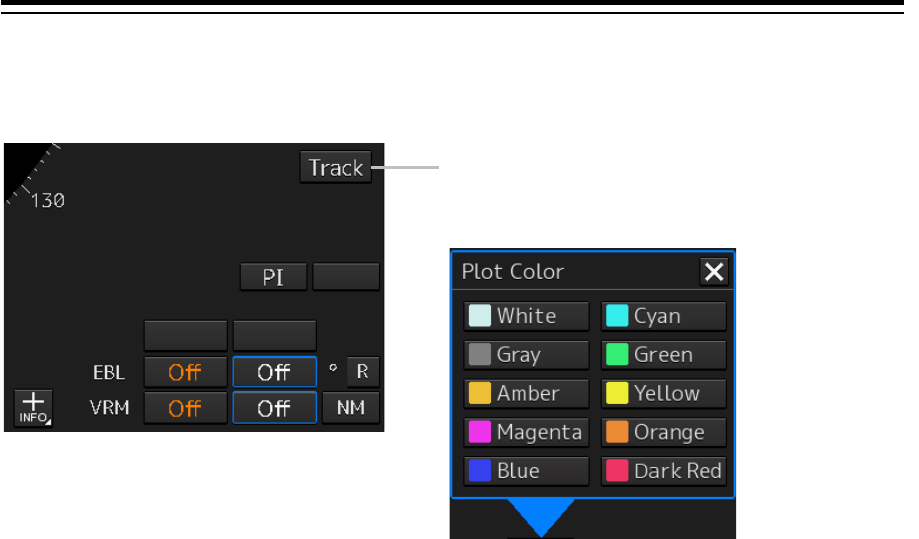
Section 2 Name and Function of Each Unit 2-54
2.4.4 Own track information
Own ship's track color setting button
When this button is clicked on, a "Plot Color" dialog box
appears. Click on the color to be used from the list.
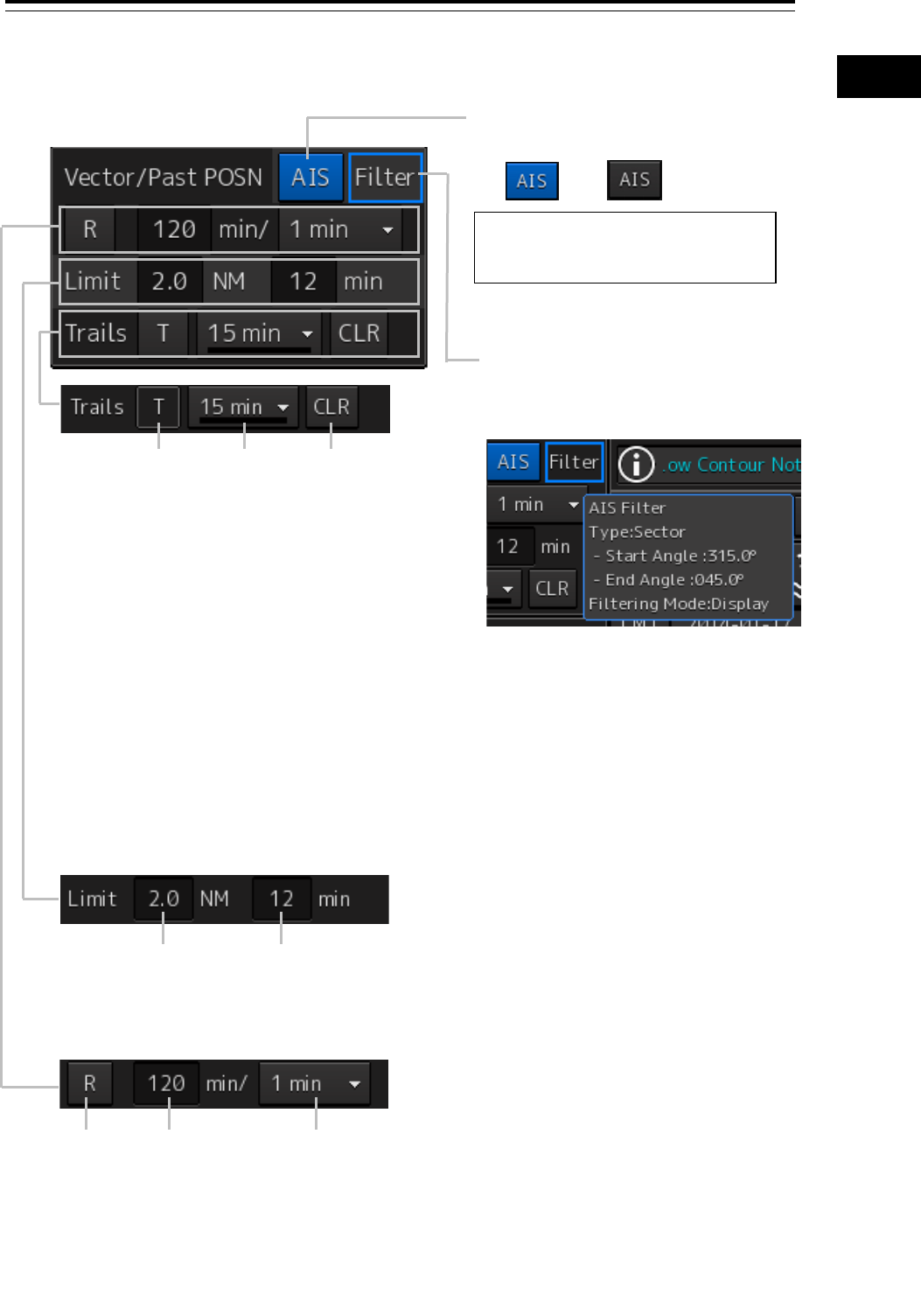
2-55 Section 2 Name and Function of Each Unit
1
2
3
4
5
6
7
8
9
10
11
12
13
14
15
16
17
18
19
20
21
22
23
24
25
APP A
APP B
1
2.4.5 Other ship information
[Filter] button
When the cursor is placed on this button
while AIS is On, the AIS Filter status is
displayed.
The following status is displayed.
Filter type
•Filter shape: For Sector, the status is
displayed with Start Angle and End
Angle, and for Ring, the status is
displayed with Distance.
•Filtering mode: Priority or Display
[AIS] button
This button sets the AIS function to On/Off.
On: Off:
Note
When AIS is set to Off, alerts relating to
AIS are also no longer displayed.
[1] Trail True/Relative switching button
This button switches the trail mode to True or
Relative.
When True is set, "T" is displayed on the button
and when Relative is set, "R" is displayed on the
button.
[2] Trail length switching combo box
This button switches the trail length.
For the details, refer to "5.4.9 Displaying radar
trails (Trails)".
[3] [CLR] (Trail Clear) button
When this button is clicked on, the trail is
cleared.
For the details, refer to "5.4.9 Displaying radar
trails (Trails)".
[1]
[2]
[1]
[2]
[3]
[1] Vector past position True/Relative switching
button
This button switches the vector past position to True or
Relative.
For the details, refer to "6.4.2.4 Setting the vector
length".
[2] Vector length input box
Enter a vector length.
For the details, refer to "6.4.2.4 Setting the vector
length".
[3] Past position interval switching combo box
For the details, refer to "6.8.1 Setting the Past position".
[1]
CPA limit value input box
Input a CPA limit value. For the details, refer to "6.4.3
Setting collision decision criteria".
[2] TCPA limit value input box
Input a TCPA limit value. For the details, refer to "6.4.3
Setting collision decision criteria".
[2]
[3]
[1]
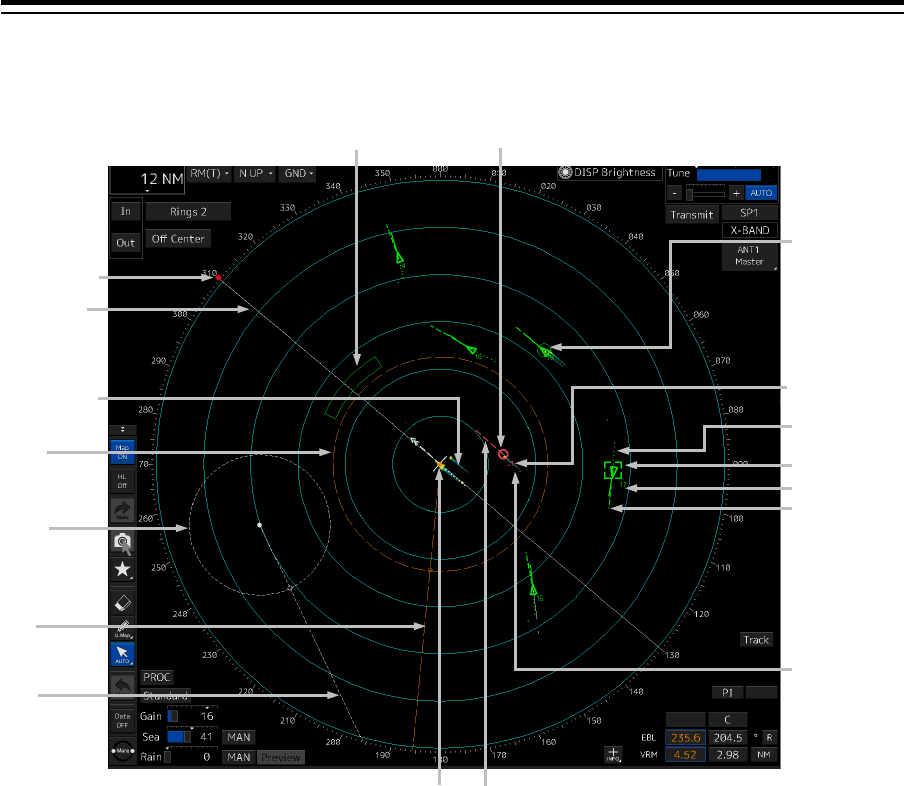
Section 2 Name and Function of Each Unit 2-56
2.4.6 Display inside the PPI
Association target
AIS
target number
Past position
Other ship's track
AIS
target symbol
VRM2
Automatic acquisition/
activation
zone
Ship's heading
marker
Own ship's symbol
Ship's heading
line
TT target number
VRM1
EBL1
EBL2
R
adar trails
AIS
target vector
Tracked target symbol
TT target symbol
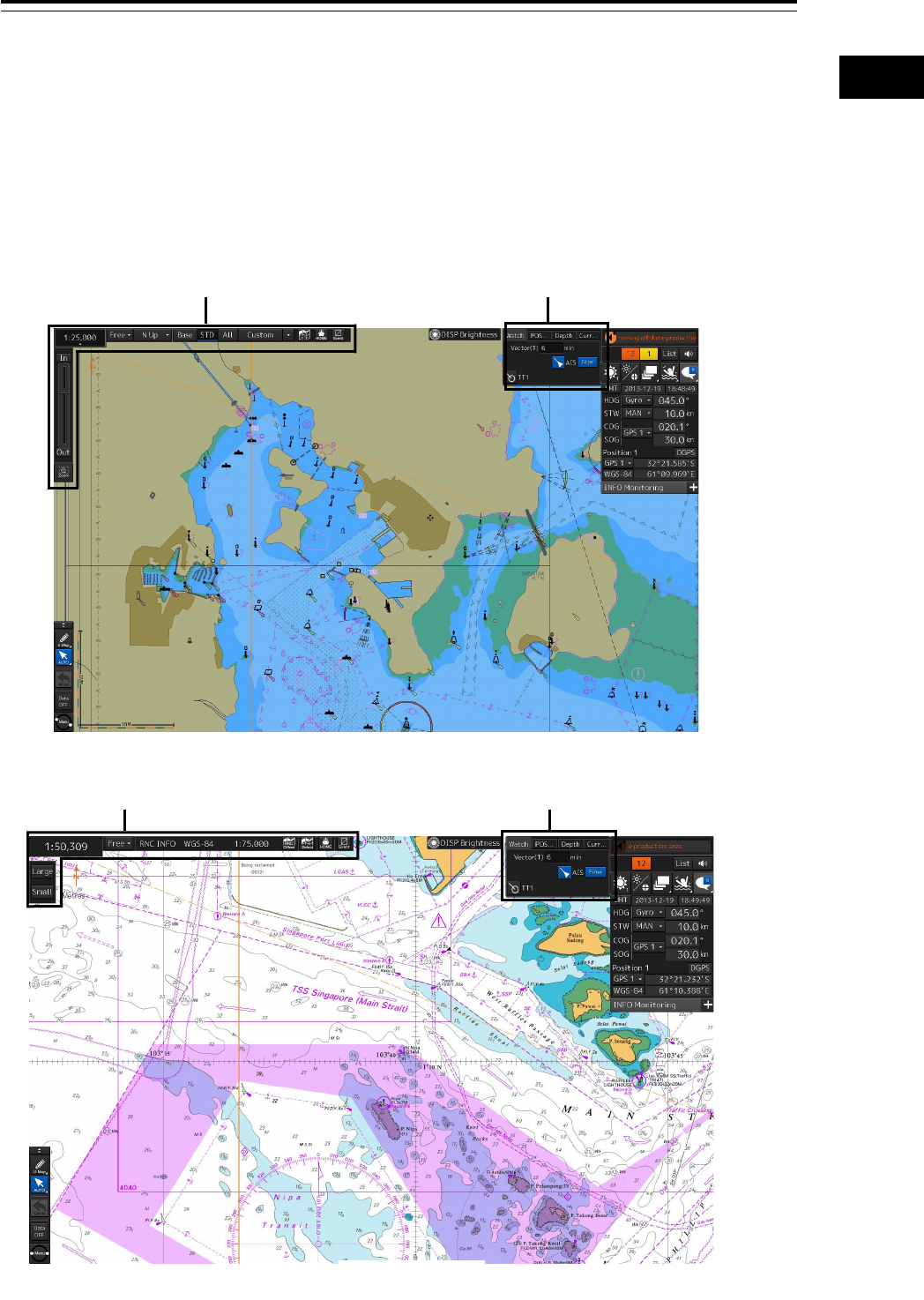
2-57 Section 2 Name and Function of Each Unit
1
2
3
4
5
6
7
8
9
10
11
12
13
14
15
16
17
18
19
20
21
22
23
24
25
APP A
APP B
1
2.5 Names and Main Functions of Each
Section of the ECDIS Screen (Option)
The screen operation units specific to ECDIS are "Chart Information Area" and "Sub Information Area".
For "Chart Information Area", the contents vary depending on whether the chart is ENC/C-MAP or
RNC.
For "Sub Information Area", the contents are common regardless of the chart type.
Refer to "2.5.1 Chart Information Area (ENC/C-MAP)".
Refer to "2.5.3 Sub Information Area".
ENC/C-MAP
Refer to "2.5.2 Chart Information Area (RNC)".
Refer to "2.5.3 Sub Information Area".
RNC
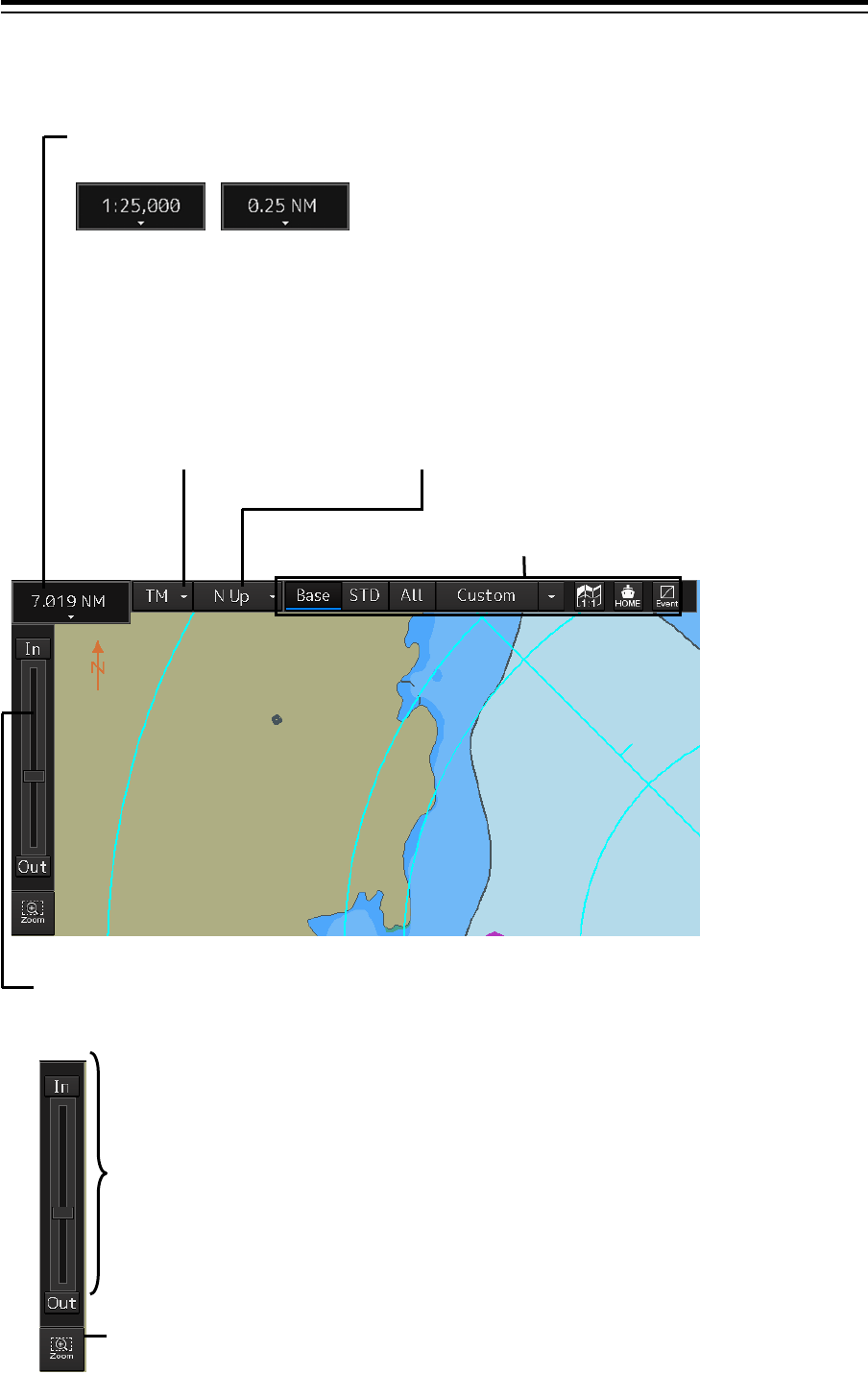
Section 2 Name and Function of Each Unit 2-58
2.5.1 Chart Information Area (ENC/C-MAP)
Scale/Range combo box
This button displays the current scale or range.
Scale display Range display
Select a scale or a range from the combo box.
For the details, refer to "8.4.3 Switching between scale and range (S-57/C-MAP only)".
Motion mode combo box
This button sets the motion mode.
For the details, refer to "8.6.1
Setting motion mode".
Bearing mode combo box
This button sets the bearing mode.
For the details, refer to "Setting Bearing mode
(S-57/C-MAP only)".
Zoom slider
The zoom slider expands/reduces the display in
scale/range.
For the details, refer to 8.4.2.2
"Enlarging/reducing with the zoom
slider (S-57/C-MAP only)".
For the details, refer to "8.4.2
Enlarging/reducing a chart
with the Zoom function".
See the next page.
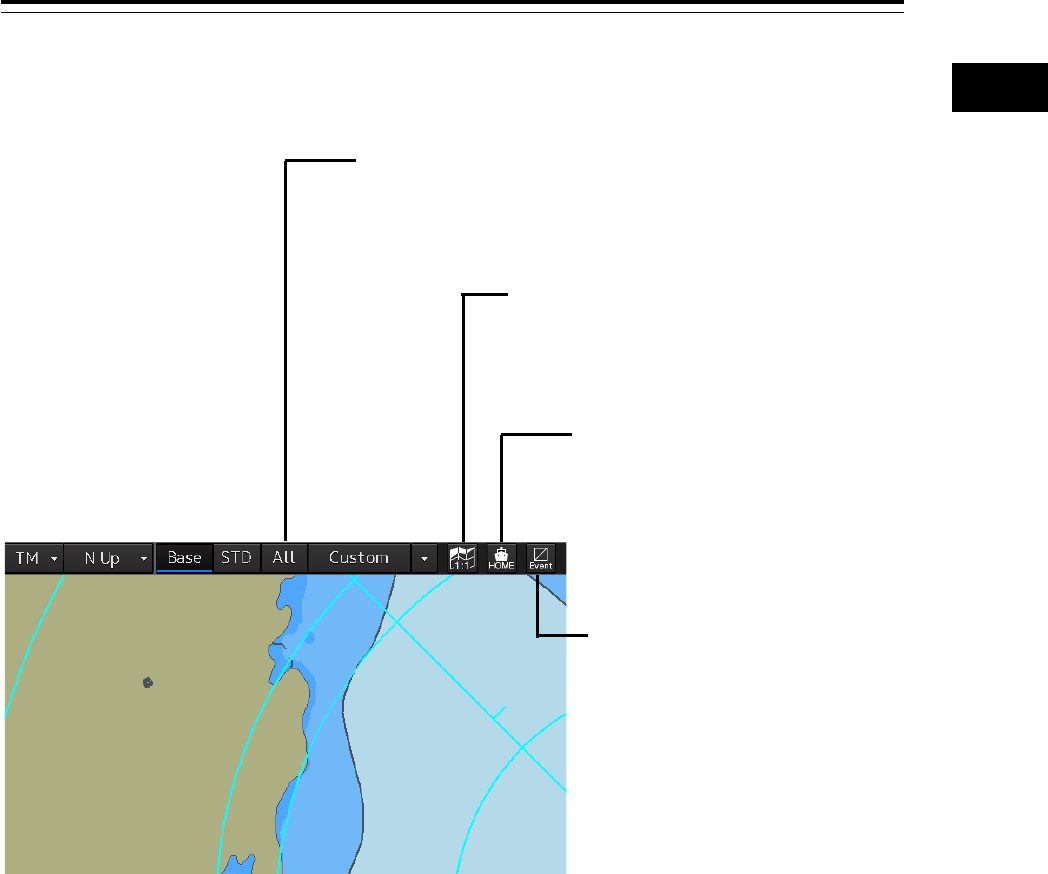
2-59 Section 2 Name and Function of Each Unit
1
2
3
4
5
6
7
8
9
10
11
12
13
14
15
16
17
18
19
20
21
22
23
24
25
APP A
APP B
1
Original scale display button
When this button is clicked on, the screen
scale is changed according to the original
scale of the chart that is displayed at the
center of the screen.
[Home] button
When this button is clicked on, the
chart screen moves to the position at
which the own ship’s position is to be
displayed.
For the details, refer to "8.3.1 Moving
the chart with the [HOME] button".
[Event] button
When this button is clicked on, an
event mark is assigned at the own
ship’s position.
For the details, refer to "8.12 Marking
the Position of Own Ship with an Event
Mark".
Display category
Set the display category of the chart.
For the details, refer to "8.5 Changing the Object Category
(S-57/C-MAP Only)".

Section 2 Name and Function of Each Unit 2-60
2.5.2 Chart Information Area (RNC)
Scale/Range button
This button displays the
current scale.
The scale cannot be
changed.
Motion mode combo box
This button sets the motion
mode.
For the details, refer to "8.6.1
Setting motion mode".
[Large] (Zoom In) / [Small] (Zoom
Out) button
This button switches the chart scale
between Large and Small
For the details, refer to "8.4.2.3
Enlarging/reducing with the Large/Small
buttons (RNC only)".
See the next page.
RNC information display
This area shows the geodetic datum and
the original scale of the chart that is
displayed.
Original scale
Geodetic datum
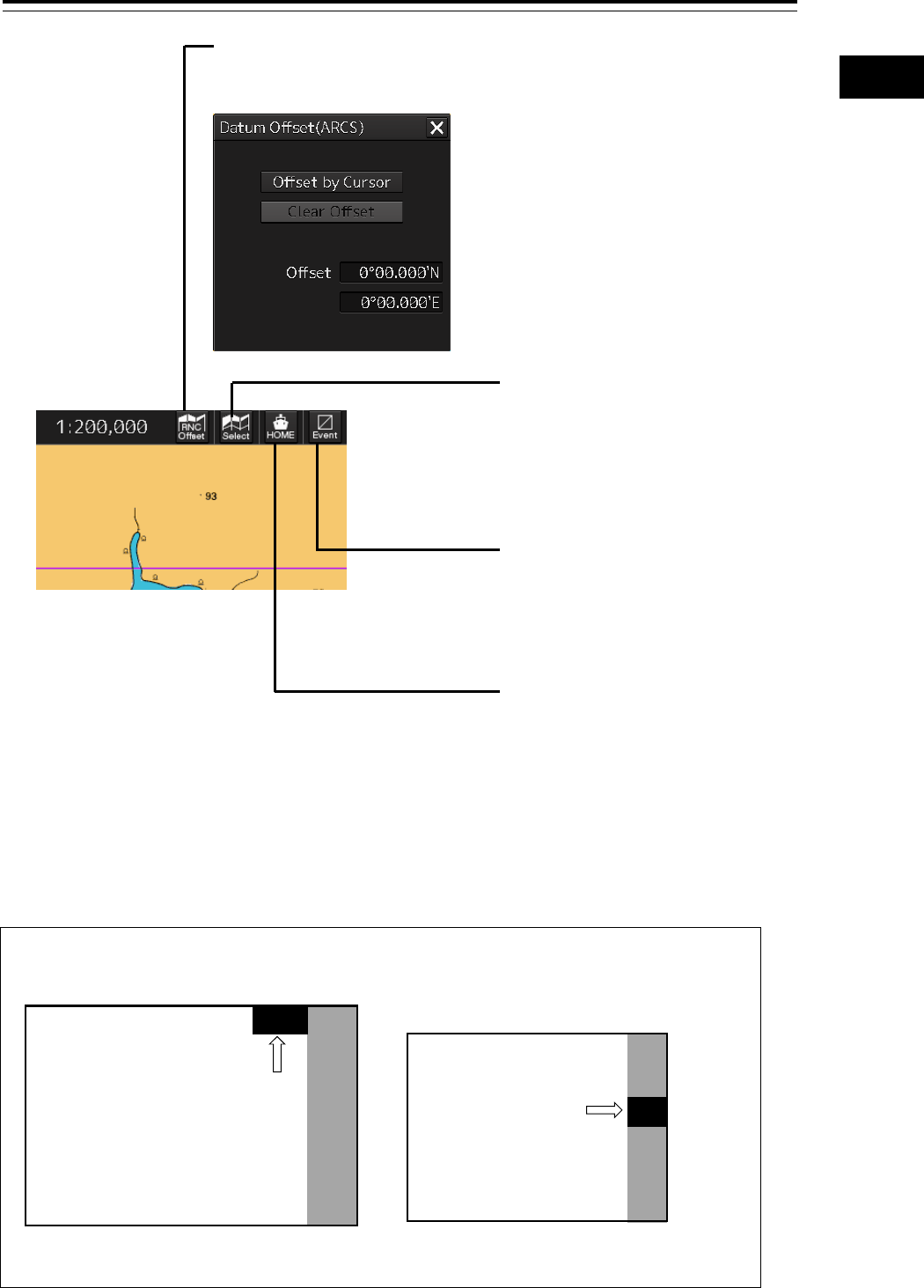
2-61 Section 2 Name and Function of Each Unit
1
2
3
4
5
6
7
8
9
10
11
12
13
14
15
16
17
18
19
20
21
22
23
24
25
APP A
APP B
1
2.5.3 Sub Information Area
Chart offset amount display
When this button is clicked on, the chart offset amount is displayed on the
dialog box.
Chart selection button
Select a chart from the "Select chart"
dialog box that is displayed by clicking on
this button.
For the details, refer to "8.9.1 Selecting
charts from all".
[Home] button
When this button is clicked on, the chart
screen is moved to the position at which
the own ship’s position is displayed.
For the details, refer to "8.3.1 Moving the
chart with the [HOME] button".
[Event] button
When this button is clicked on, an event
mark is assigned at the own ship’s position.
For the details, refer to "8.12 Marking the
Position of Own Ship with an Event Mark".
Memo
• The display position of Sub Information Area varies according to the display size.
26inch screen (WUXGA) 19inch screen (SVGA)
Display position
Display
position
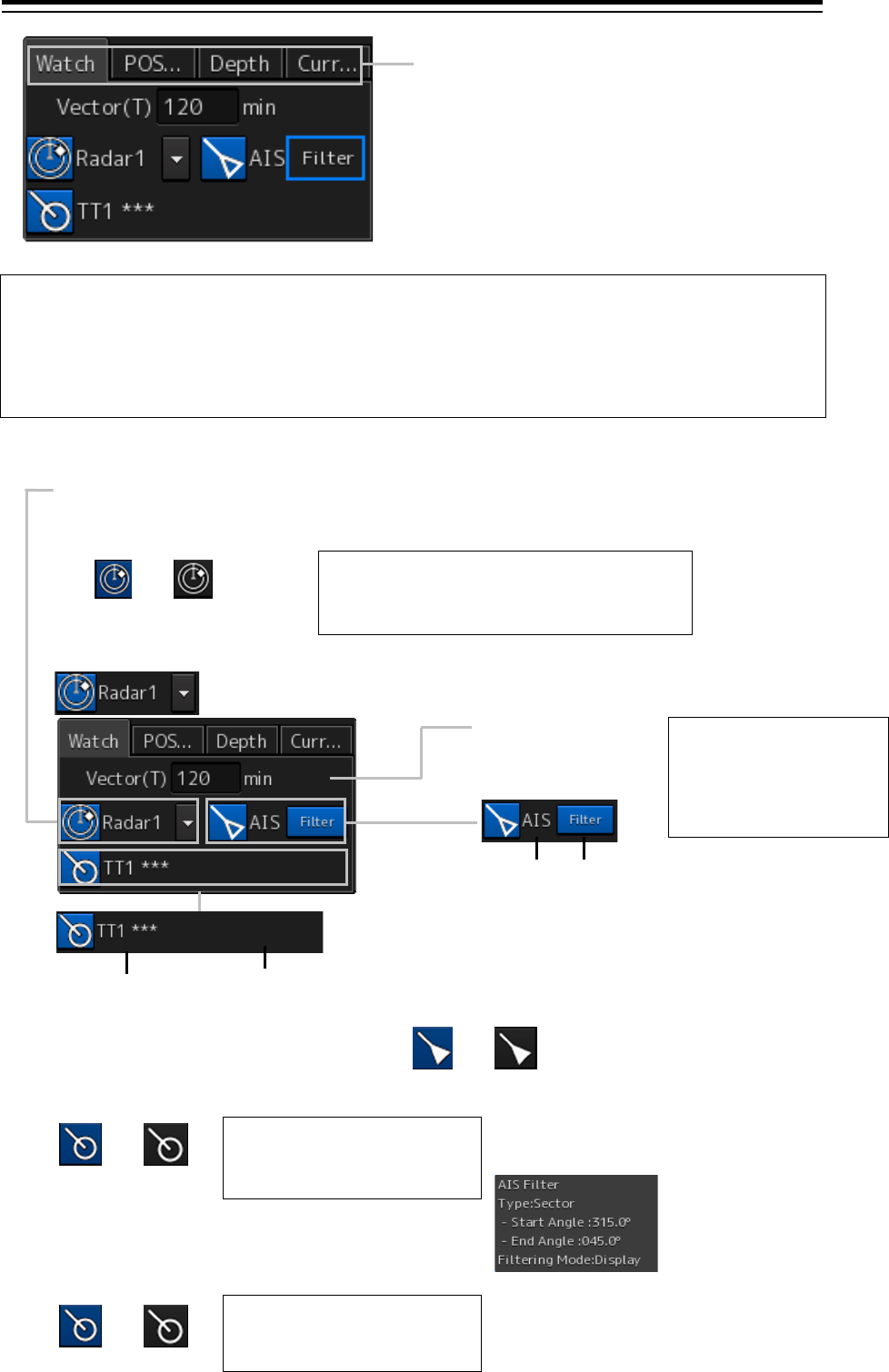
Section 2 Name and Function of Each Unit 2-62
Memo
The tab that is displayed varies depending on the setting.
To set up, select [View] - [Options] - [Control] on the menu.
For the details, refer to "16.2.15 Setting up Display of Own Ship Track Control, Display Format of
Own Ship/Cursor Position and Display of Sub-Information Dialog".
[1] [Watch] (Monitoring) window
Switching tab
When this tab is clicked on, the contents of the
dialog are switched.
[1] [Watch] (Monitoring) dialog
[2] [POSN DIFF] (Position/distance
difference) dialog
[3] [Depth] (Depth) dialog
[4] [Current] (Current) dialog
[a] TT1 display button
This button displays the TT1 On/Off status
and switches the status.
Whenever this button is clicked on, the
display is switched to On/Off.
On: Off:
[b] TT2 display button
This button displays the TT2 On/Off status
and switches the status.
Whenever this button is clicked on, the
display is switched to On/Off.
On: Off:
[Vector(T)] input box
Enter a vector length.
Input range: 1 to 120
Radar Overlay display button
This button displays the Radar Overlay On/Off status and switches the status.
Whenever this button is clicked on, the display is switched to On/Off.
On: Off:
[When there are multiple radars]
Select a Radar Overlay to be used from the combo box.
[a] AIS button
This button displays the AIS On/Off status and switches the
status.
Whenever this button is clicked on, the display is switched to
On/Off.
On: Off:
[b] [Filter] status display
When AIS is set to On, if placing the cursor on
this button, the AIS filter status is displayed.
[a]
[b]
[a]
[b]
Note
When the button is turned OFF, even the alerts
related to the radar will not be displayed.
Note
When the button is turned
OFF, even the alerts related
to the AIS will not be
displayed.
Note
When the button is turned OFF, even
the alerts related to the TT will not be
displayed.
Note
When the button is turned OFF, even
the alerts related to the TT will not be
displayed.
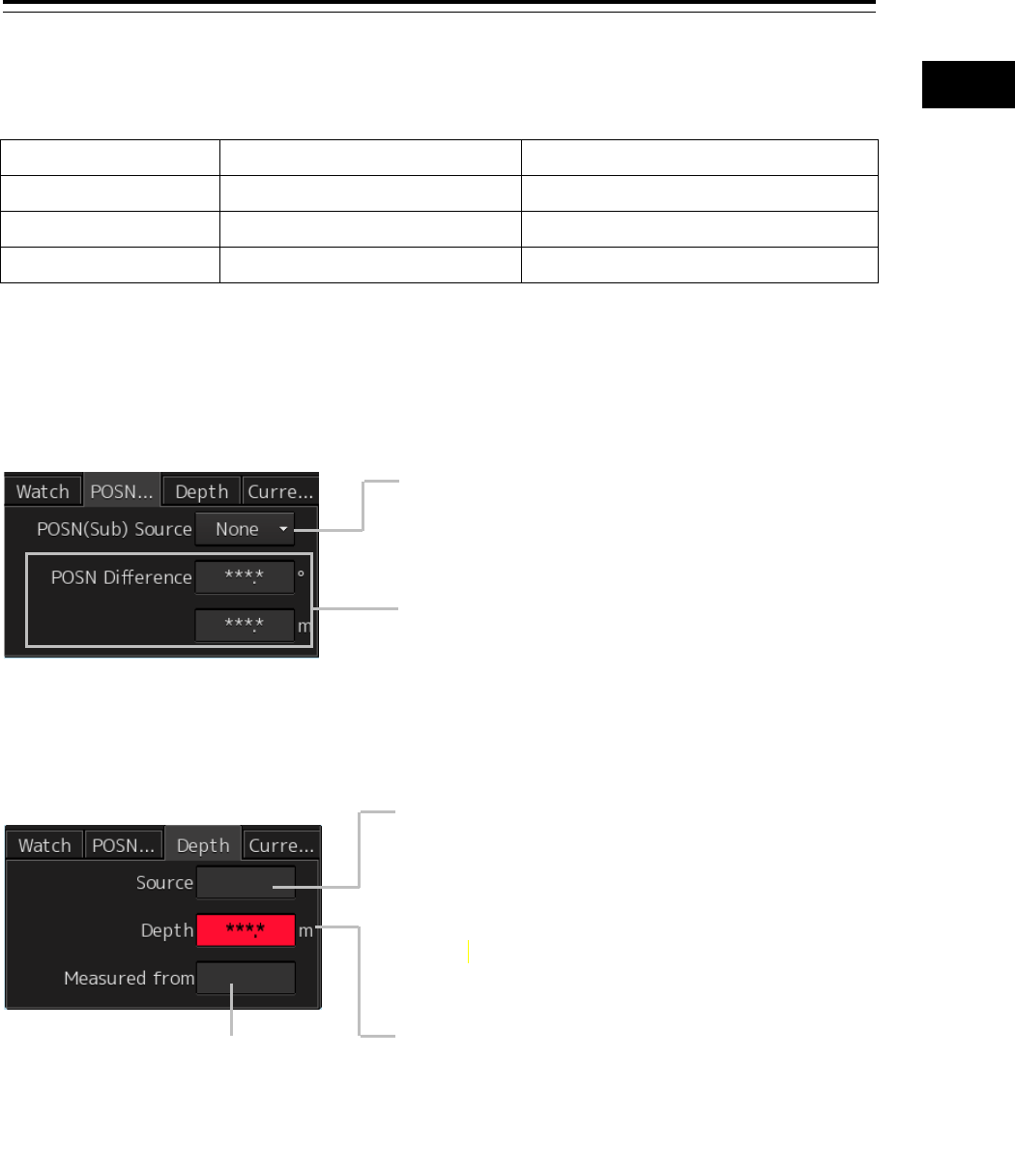
2-63 Section 2 Name and Function of Each Unit
1
2
3
4
5
6
7
8
9
10
11
12
13
14
15
16
17
18
19
20
21
22
23
24
25
APP A
APP B
1
Display names of the TT1 display button and the TT2 display button
At the end of the display name, REL, GND, or SEA is displayed depending on the motion mode and
stabilization mode. (Example: TT1-GND)
Display characters Motion mode Stabilization mode
REL Relative motion display (RM) –
GND True motion display (TM) Ship speed relative to land
SEA True motion display (TM) Ship speed relative to water
To use a TTM sentence for TT symbol display, the OSD sentence must be received from RADAR.
[2] [POSN DIFF] dialog
Displays the difference of bearing and distance between POSN(Main) and POSN(Sub).
[3] [Depth] dialog
Displays the water depth.
[POSN(Sub) Source] combo box
Displays the source of the sub position.
When there are multiple sub position sources, select a
source from the combo box.
[POSN Difference]
Displays the difference of bearing and distance between
POSN(Main) and POSN(Sub).
[Source]
Displays the depth sounder that is used.
FWD: Depth sounder installed at the front of the ship
MID: Depth sounder installed at the center of the ship
AFT: Depth sounder installed at the rear of the ship
None: Hides the [Depth] tab.
When a depth sounder is not installed, the
[Depth] tab is not displayed.
[Measured from]
Displays the water depth measurement
reference position.
Transducer: Transducer
Surface: Water surface
Keel: Keel
[Depth]
Displays the water depth.
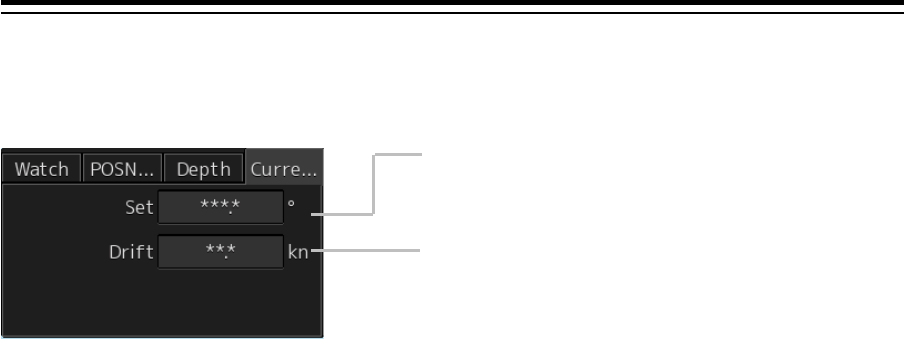
Section 2 Name and Function of Each Unit 2-64
[4] [Current] dialog
Displays the bearing and speed of the current.
2.5.4 ARCS PIN input dialog box
When an ARCS chart is imported, a dialog box for entering an ARCS PIN is displayed at the startup of
the ECDIS mode.
For the details, refer to "8.2.3 Entering an ARCS PIN Number (ARCS Only)".
[Set]
Displays the bearing of the current.
[Drift]
Displays the speed of the current.
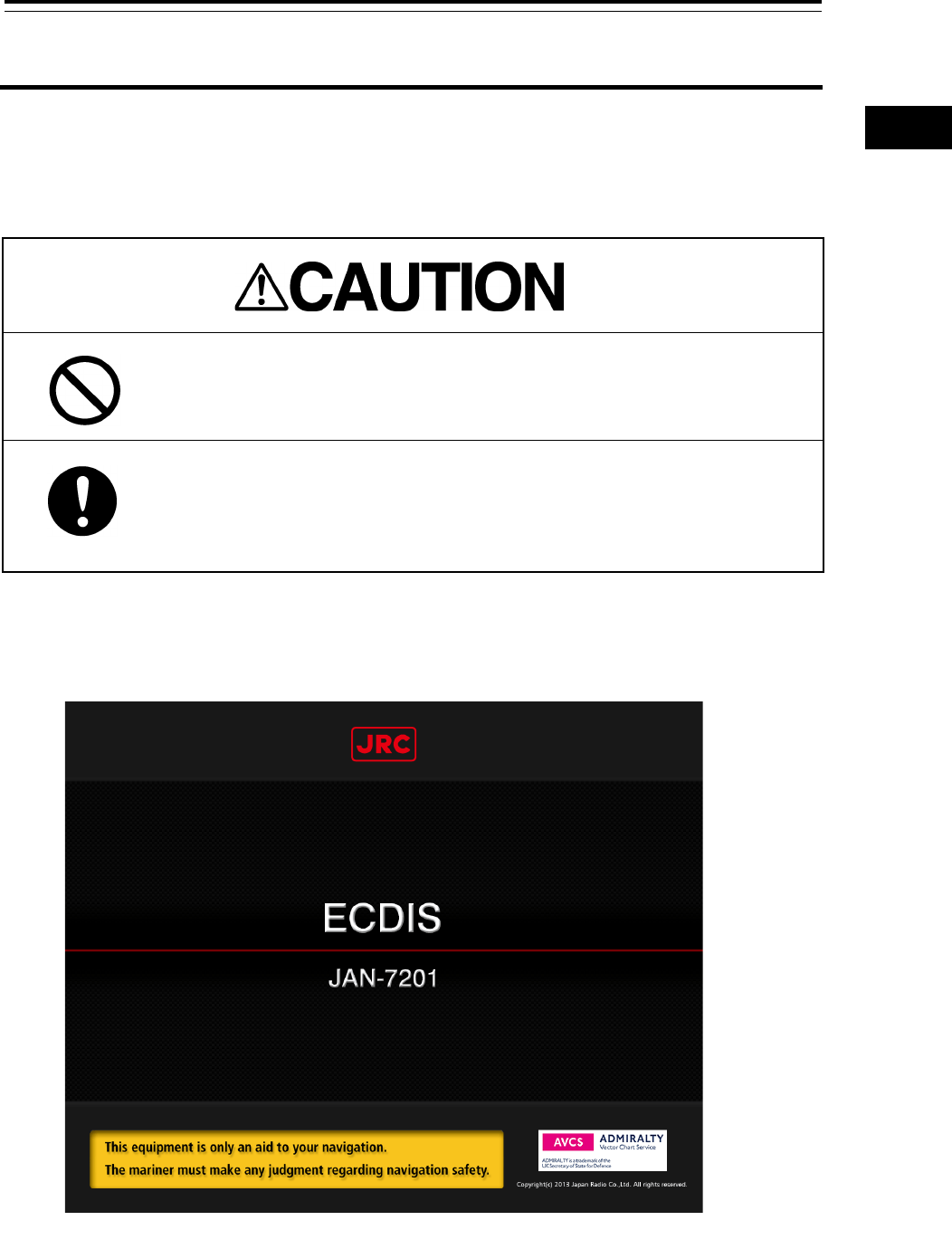
3-1 Section 3 Common Basic Operations
1
2
3
4
5
6
7
8
9
10
11
12
13
14
15
16
17
18
19
20
21
22
23
24
25
APP A
APP B
1
Section 3
Common Basic Operations
3.1 Powering On and Starting
Turn on the power supply according to the following procedure.
Do not leave the disc in the DVD drive.
Malfunctions of the drives may result.
For low-temperature start-up, perform pre-heat for more than 30
minutes.
Otherwise, an operation failure may occur and an accident may occur.
1 Press the Power button on the operation unit.
The Power button is lit and the start-up screen is displayed.
ECDIS

Section 3 Common Basic Operations 3-2
Memo
• At the center of the start-up screen, "RADAR" (in the case of RADAR), "ECDIS" (in the
case of ECDIS), or "CHART RADAR" (in the case of CHART RADAR) is displayed
depending on the type of the equipment.
• When the power is supplied while all the power supplies are disconnected, the indicator
can be started automatically without pressing the Power button.
After the start-up screen is displayed, the task menu is displayed after a brief interval.
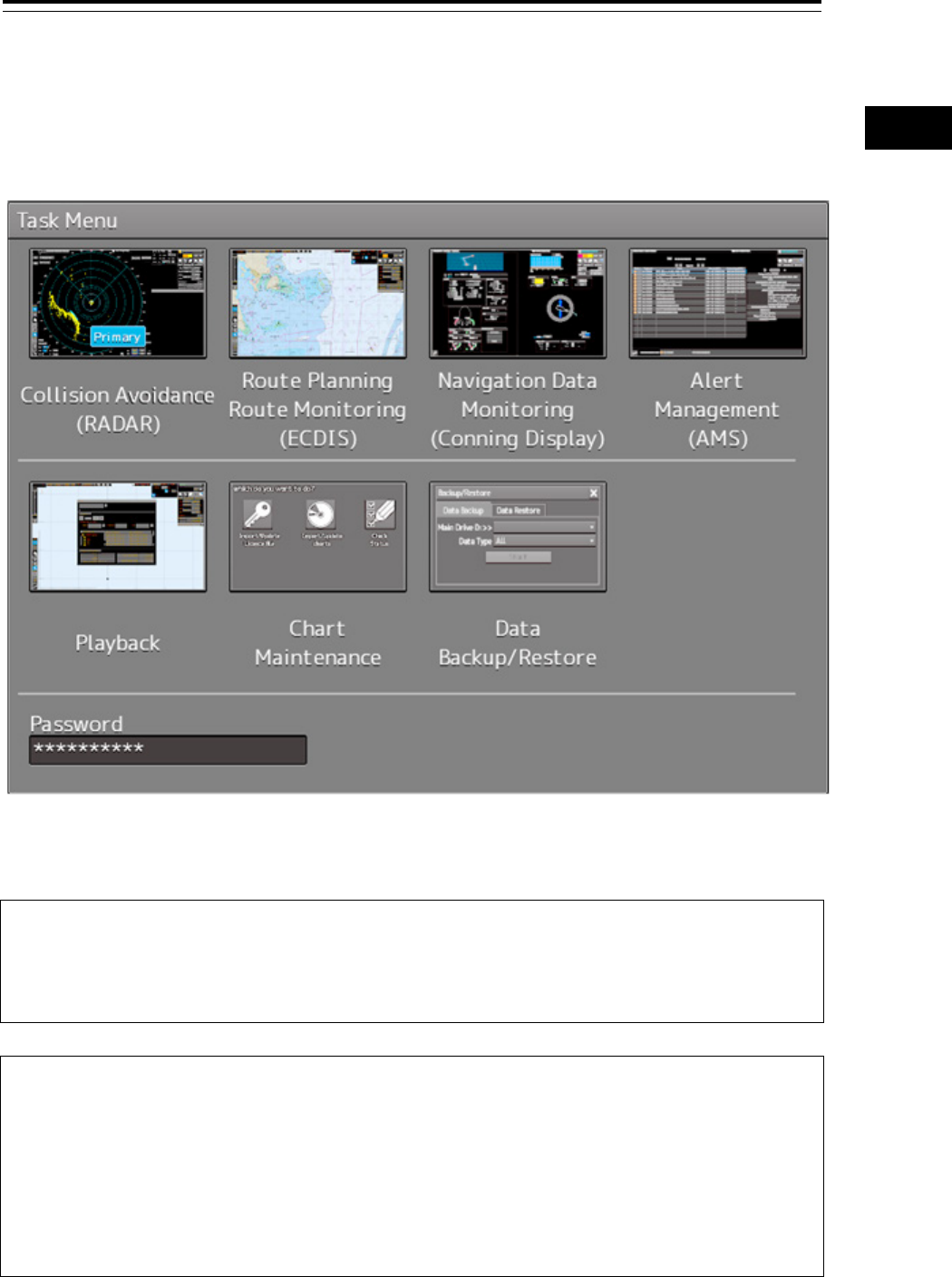
3-3 Section 3 Common Basic Operations
1
2
3
4
5
6
7
8
9
10
11
12
13
14
15
16
17
18
19
20
21
22
23
24
25
APP A
APP B
1
3.2 Starting Each Mode
When this equipment starts up, a task menu is displayed on the screen.
On the Task menu, you can select and start the desired mode from the operation modes available for
this equipment.
When the button of the mode to be executed is clicked on, the screen of the mode is displayed.
Note
When this equipment is started for the first time, if no operation is performed within 10 seconds
after the task menu is displayed, the mode screen that has been set up at the time of shipment will
appear.
Memo
Navigation Data Monitoring (Conning Display) is displayed as valid when the device Licence of
Conning Display is available. For the handling of Conning Display, refer to “JAN-7202/9202
Conning Display Instruction Manual”.
Alert Management (AMS) is displayed as valid when the Device Licence of AMS is available. For
the handling of AMS, refer to “JAN-9202/7202 Bridge Alert Management System (BAMS)
Instruction Manual”.
Task Menu Display Example
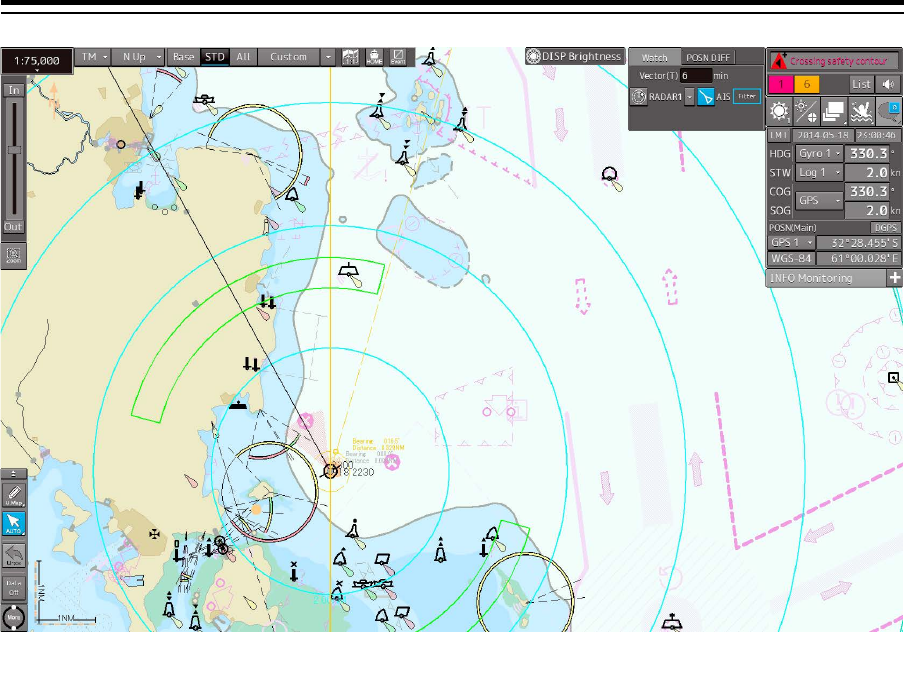
Section 3 Common Basic Operations 3-4
ECDIS
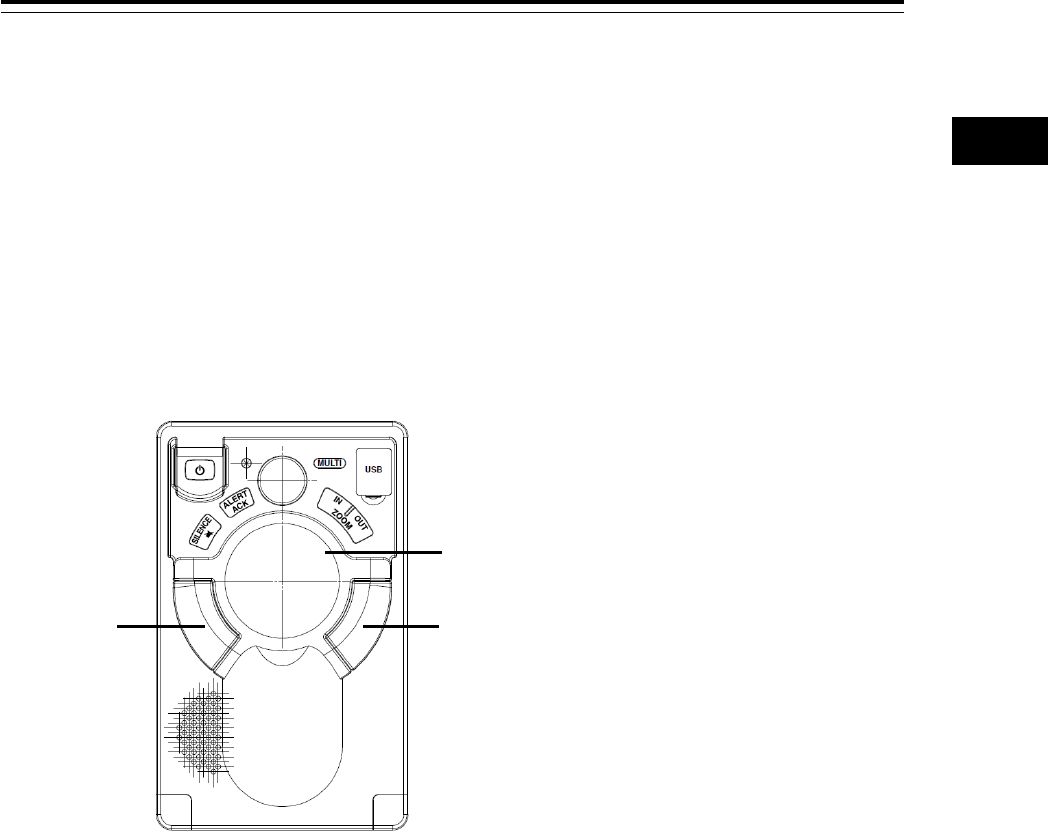
3-5 Section 3 Common Basic Operations
1
2
3
4
5
6
7
8
9
10
11
12
13
14
15
16
17
18
19
20
21
22
23
24
25
APP A
APP B
1
3.3 Basic Operations when using a
Trackball
A trackball in the trackball operation unit is mainly used for the operations of this equipment.
This section describes the basic operations performed using the trackball.
3.3.1 Basic trackball operations
As the basic trackball operations, move the cursor that is displayed on the screen and perform various
operations using the left and right mouse buttons.
3.3.2 Basic click operations
3.3.2.1 Selecting a button
When the cursor is set to a button and the button is clicked on, the function of the selected button is
executed.
• When a function On/Off button is clicked on, the setting is switched to On/Off each time.
• When a function selection button is clicked on, the function selection menu is displayed.
3.3.2.2 Selecting a single object
When the cursor is set to an object and the button is clicked on, the primary action (primary operation)
related to the target object is performed.
For example, when the cursor is set to the sleeping AIS target and the button is clicked on, "Activate"
which is the primary action of the sleeping AIS target is performed.
Right button
Left button
Trackball
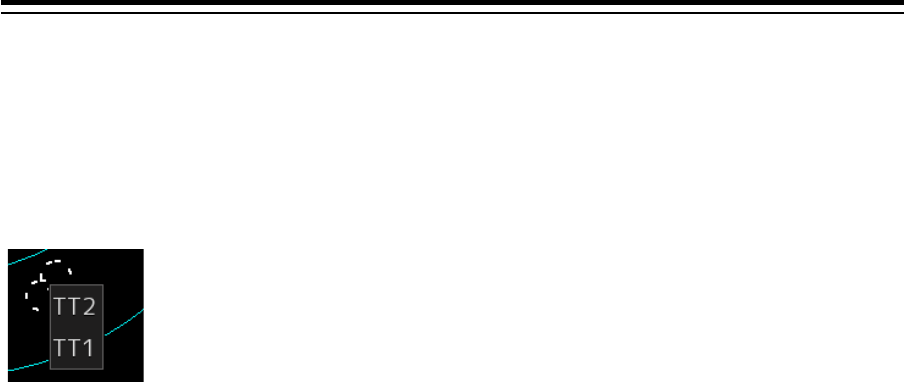
Section 3 Common Basic Operations 3-6
3.3.2.3 Selecting multiple objects
When the cursor is set to multiple objects and the button is clicked, a list menu of the target objects is
displayed.
When an object is selected from the menu, the AUTO mode operation of the selected object is
executed.
When the cursor is set to multiple objects and the right button is clicked, a target object list menu is
displayed.
When an object is selected from the menu, the context menu of the selected object is displayed.
3.3.3 Basic operations of double-clicking
Double-click the button to end the creation mode in line creation mode or creation of a graphical route.
3.3.4 Basic operations of clicking the right button
When the cursor is positioned on the target object and the right mouse button is clicked, the context
menu of the target object appears.
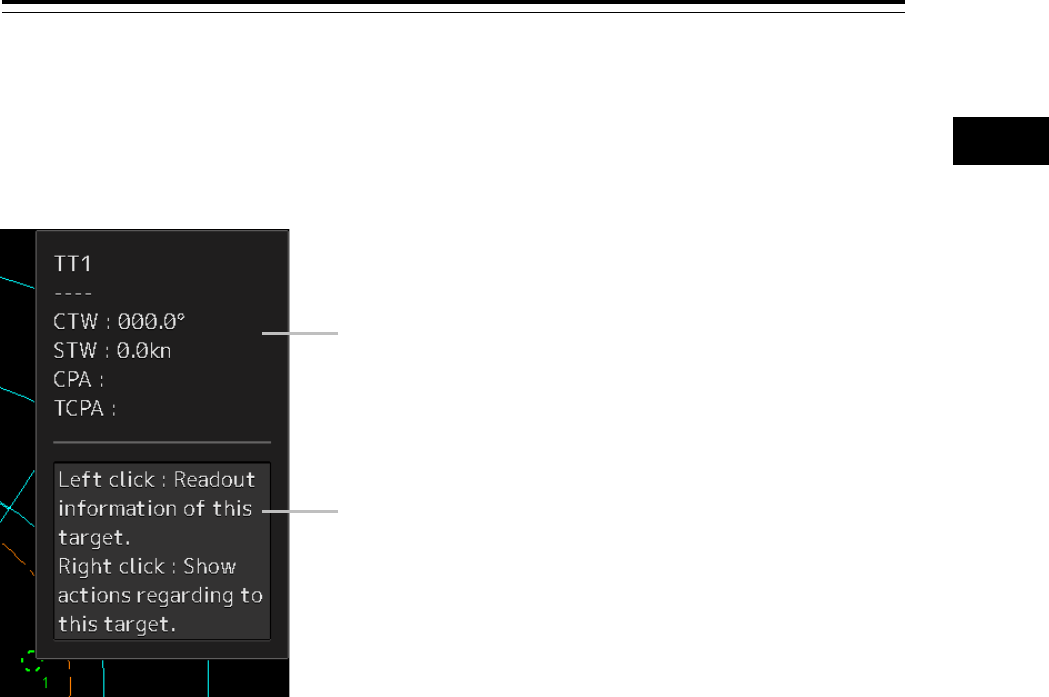
3-7 Section 3 Common Basic Operations
1
2
3
4
5
6
7
8
9
10
11
12
13
14
15
16
17
18
19
20
21
22
23
24
25
APP A
APP B
1
3.3.5 Displaying simplified information and
operational guide of objects
When the cursor is set to a specific object, the "simplified information" and "operational guide" are
displayed.
When the cursor is moved, the display is cleared.
Simplified information
Operational guide
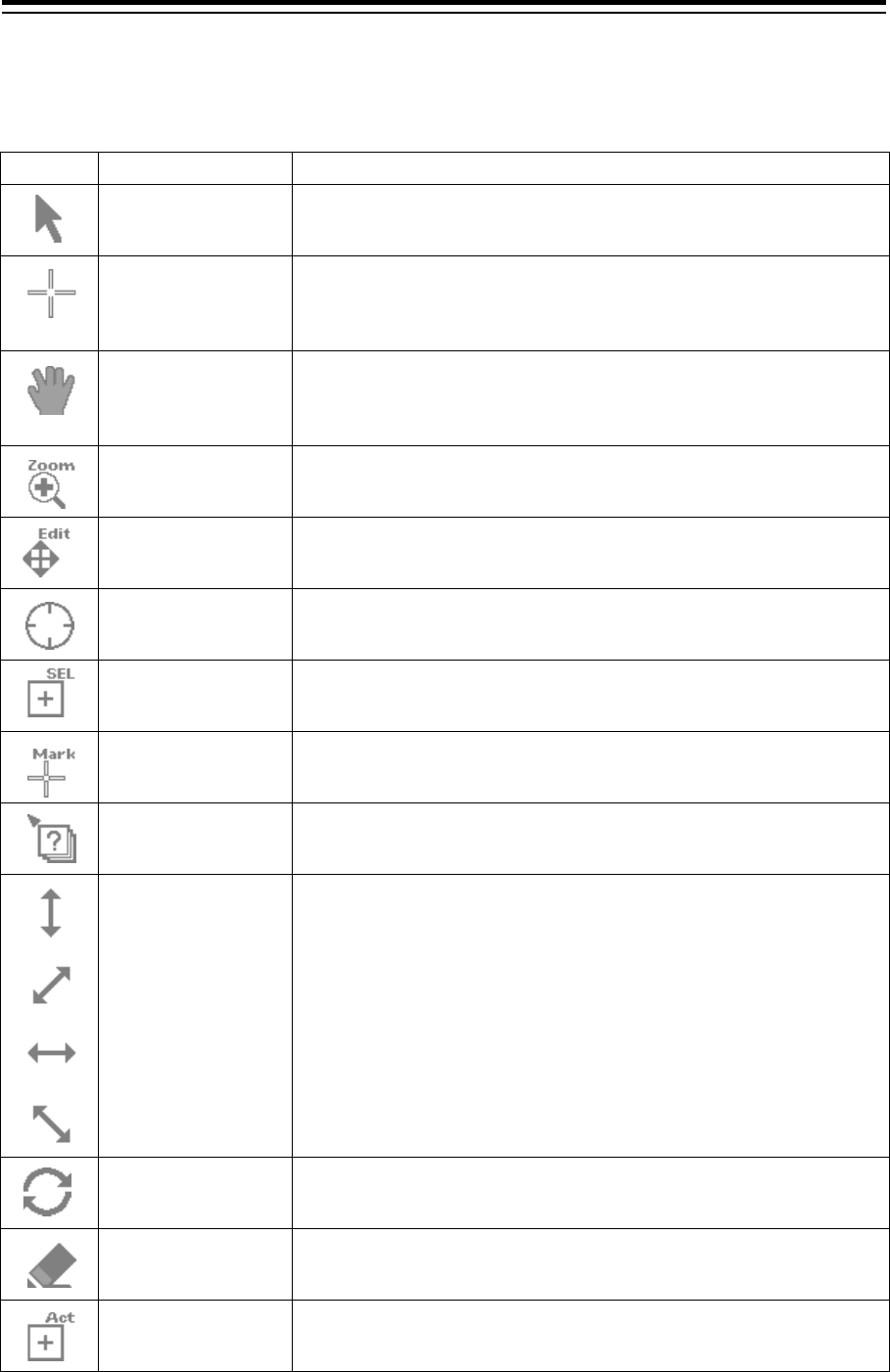
Section 3 Common Basic Operations 3-8
3.3.6 Cursor types
The following cursors are displayed by this equipment.
Cursor
Cursor Name
Description
Pointer cursor Indicates a position on the display panel, menu bar, dialog box, or
context menu.
Cross-hair cursor Indicates a position on the chart or PPI.
In AUTO mode, this cursor is used by an off-centering function
(ECDIS) or manual acquisition (RADAR).
Hand cursor Appears when the cursor is moved while pressing the left button
on a chart. This function enables moving the position freely by
dragging the chart.
Zoom cursor Appears when a zoom function is selected.
Edit cursor Moves an object in user map/manual update/mariner’s mark, or
route graphic mode.
Offset cursor Appears when the offset of the ship’s own position is set in
adjustment cursor mode.
Select cursor Displays the position on the chart during the editing of the user
map/manual update/mariner’s mark and route graphics.
Mark cursor Displayed at execution of User Map/Manual Update/Mariner’s
Mark, route plan (addition of WPT), or Manual Position Fix.
Chart selection
cursor
Appears when the chart under the ENC/ARCS cursor is selected
or Change Active Panel of ARCS is set.
Arrow cursors Appear when any of the following operations is performed.
• EBL/VRM, AIS filter, AZ, PI
• User map/manual update
• Moving the multi-view bar
• Operation of EBL, VRM
Rotation cursor Appears at PI operation or in route rotation mode of route planning.
Eraser cursor Appears in eraser tool mode.
Target activation
cursor
Appears when the cursor is moved over a sleeping AIS target.
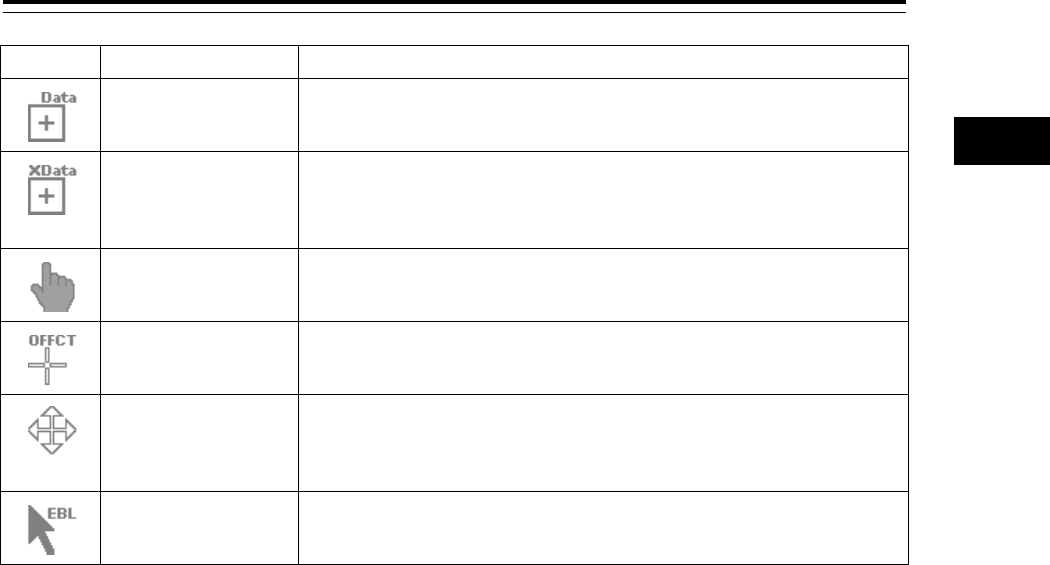
3-9 Section 3 Common Basic Operations
1
2
3
4
5
6
7
8
9
10
11
12
13
14
15
16
17
18
19
20
21
22
23
24
25
APP A
APP B
1
Cursor
Cursor Name
Description
Numeric displayed
AIS target cursor
Appears when the cursor is moved over an activated AIS target or
TT.
Numeric displayed
AIS target
cancellation cursor
Appears when the cursor is moved over an AIS digital information
target or a TT digital information target.
Pointer cursor Appears when the cursor is moved over a hyperlink.
Off-center cursor Appears when the RADAR off-centering mode is used.
Move cursor • Appears during the dialog box move mode.
• Appears when moving an intersection point of EBL/VRM.
• Appears when moving Node Fixed EBL/VRM.
EBL cursor Appears at EBL maneuver is created.
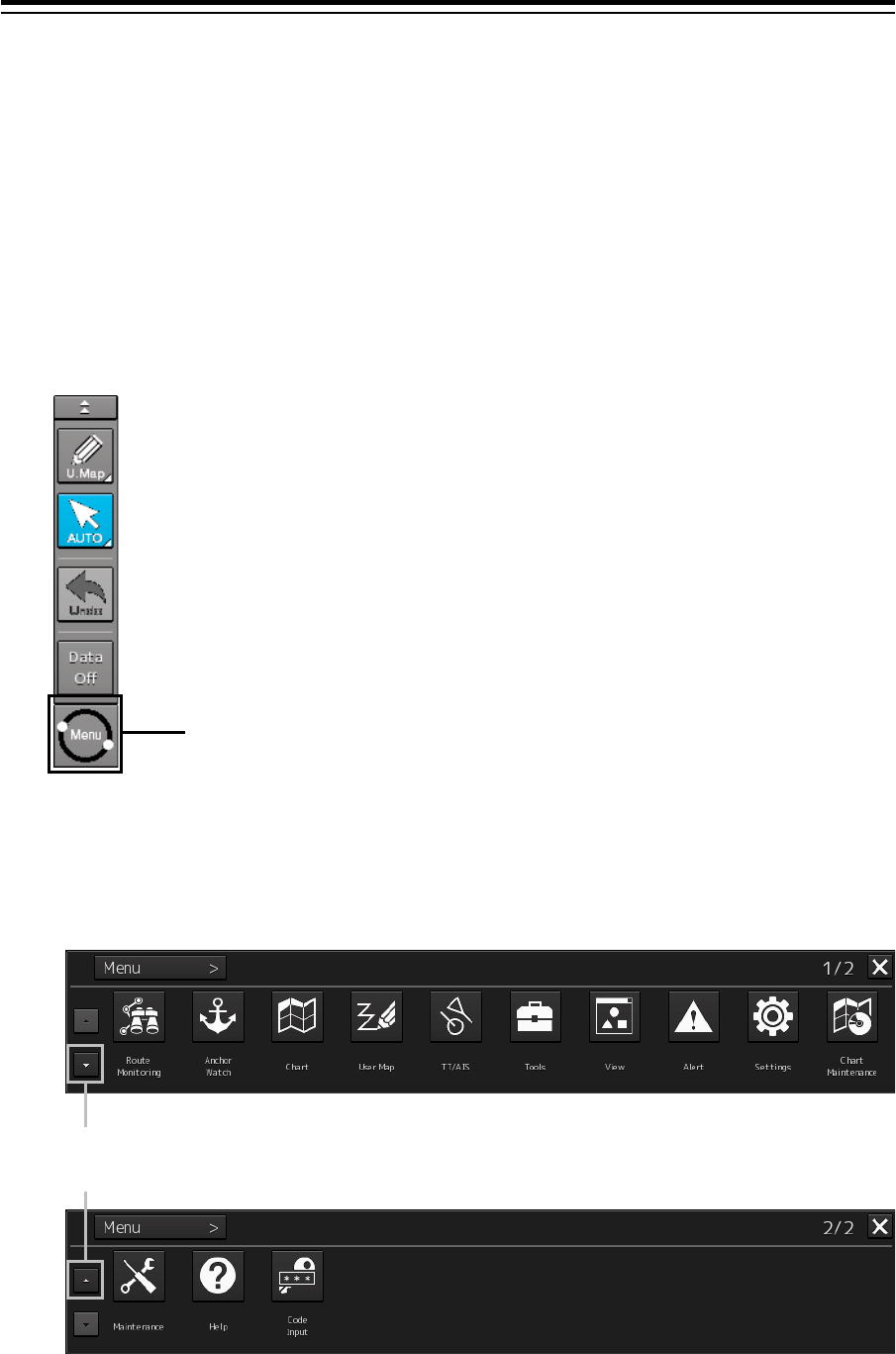
Section 3 Common Basic Operations 3-10
3.4 Basic Menu Operations
Various functions can be executed or set from the menu that is displayed by clicking on the [Menu]
button.
This section describes the basic menu operations.
3.4.1 Opening the menu
1 Click on the [Menu] button on the left toolbar.
The menu is displayed.
[For RADAR]
The menu screen comprises two pages.
Page switching button:
Switch the menu screen by clicking on the button.
[Menu] button
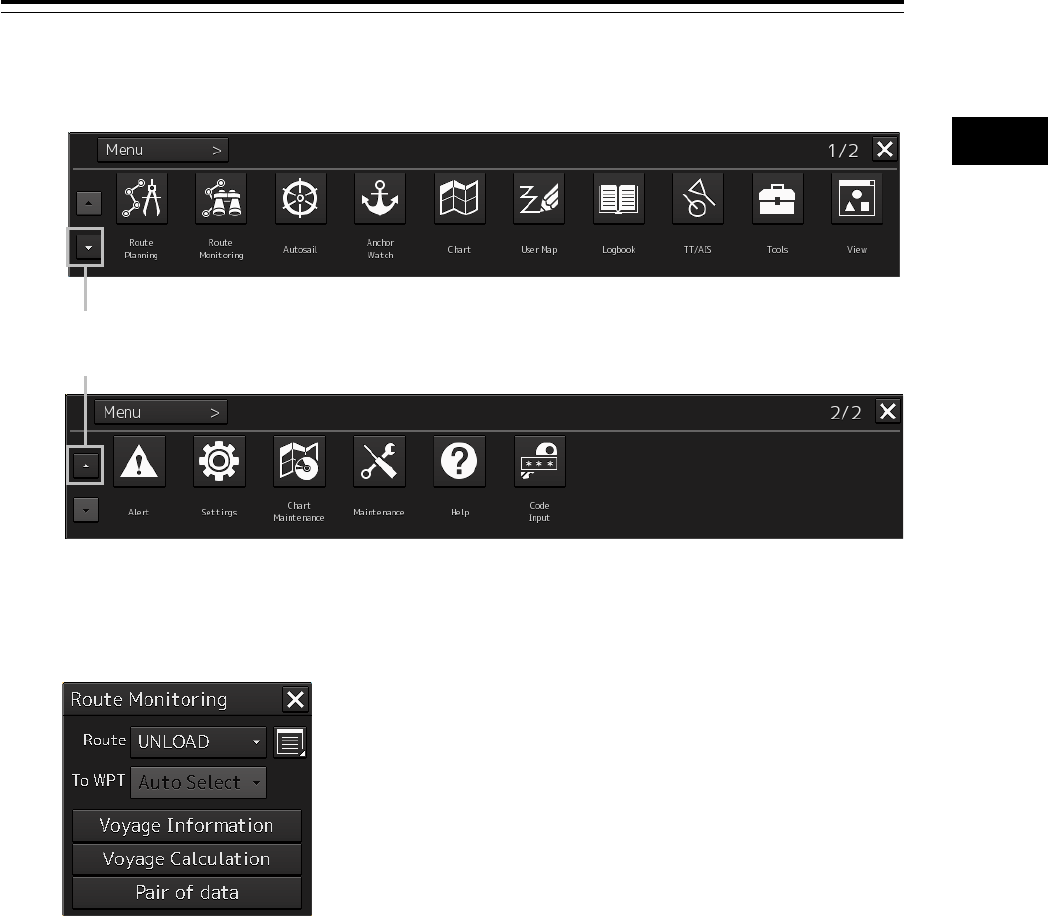
3-11 Section 3 Common Basic Operations
1
2
3
4
5
6
7
8
9
10
11
12
13
14
15
16
17
18
19
20
21
22
23
24
25
APP A
APP B
1
[For ECDIS]
The menu screen comprises two pages.
Page switching button:
Switch the menu screen by clicking on the button.
2 Click on one of the buttons that are displayed on the menu.
A dialog box for executing or setting the applicable function appears.
Display Example
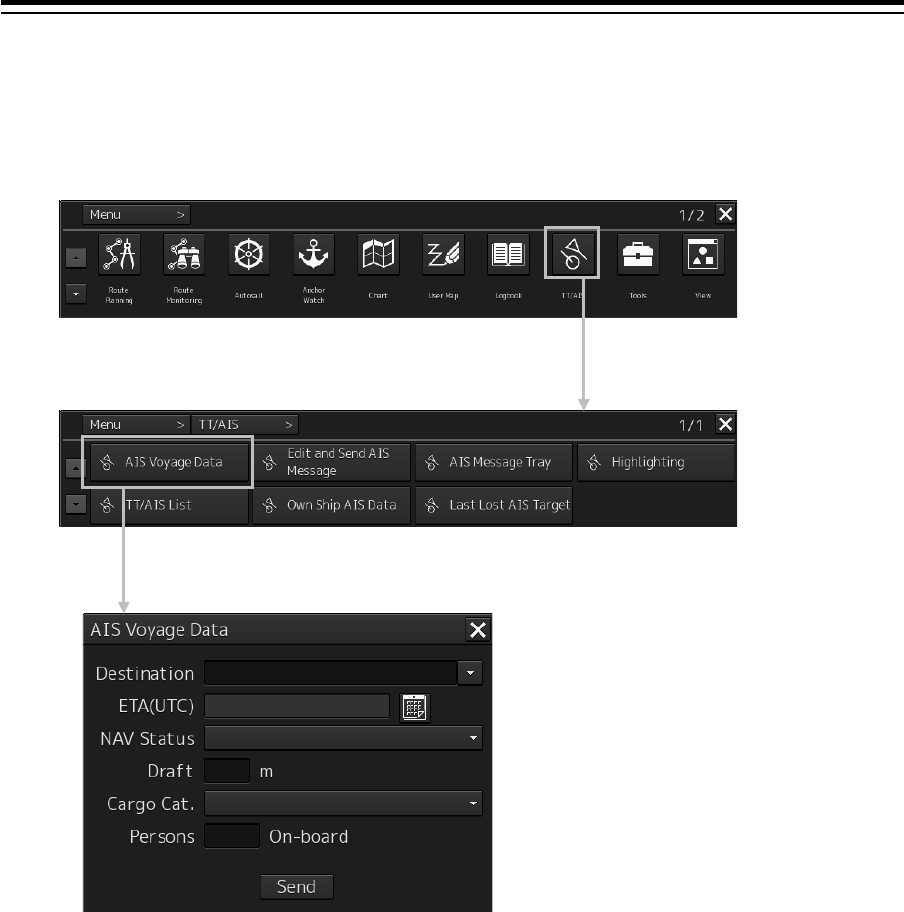
Section 3 Common Basic Operations 3-12
3 A submenu is displayed depending on the function. In this case, display a dialog box
of the function by clicking on the button on the submenu.
Example: TT/AIS
Top menu of
TT/AIS
Submenu of
TT/AIS
When the submenu screen extends over two pages, similar to the menu
screen, it is possible to switch between the pages using the page change
buttons.
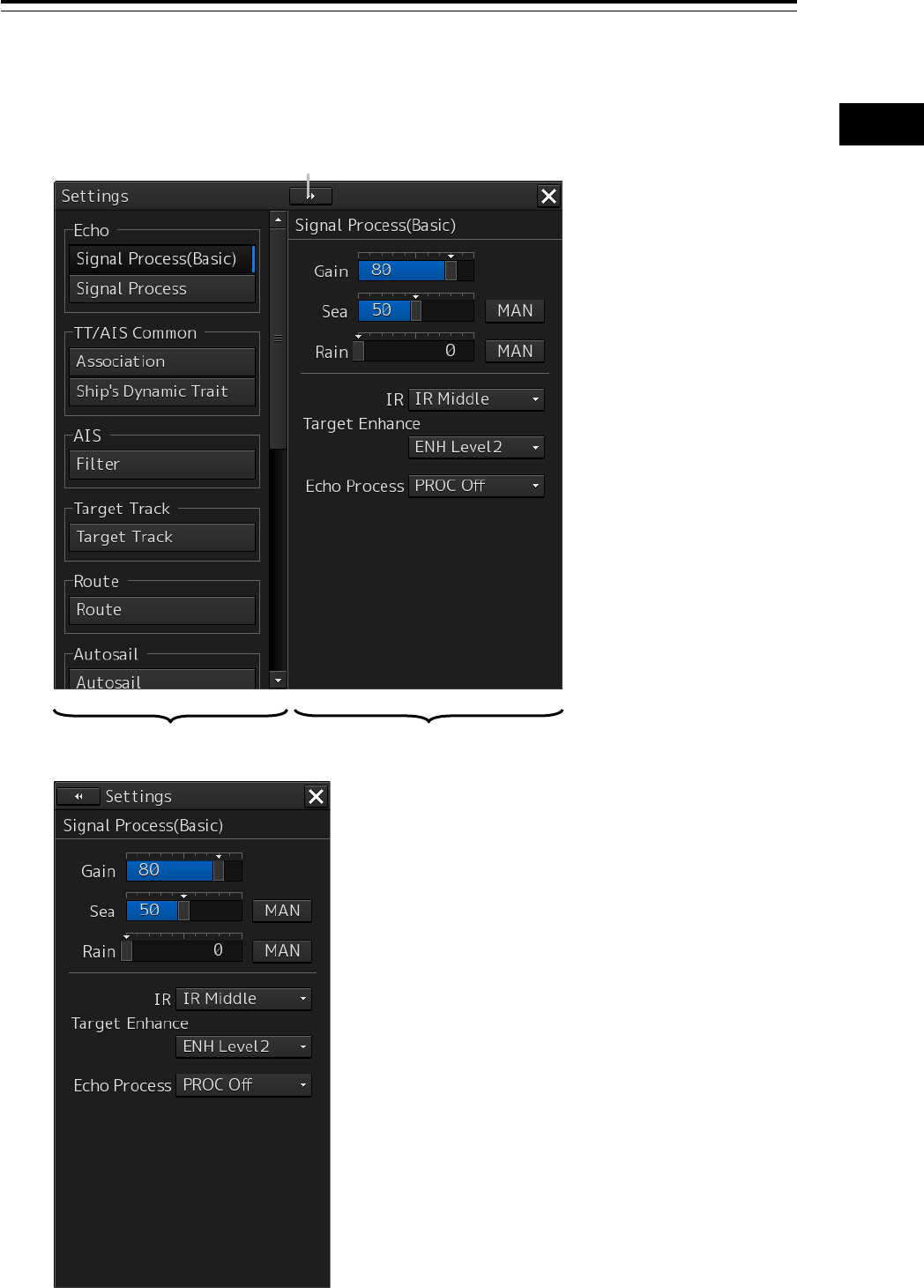
3-13 Section 3 Common Basic Operations
1
2
3
4
5
6
7
8
9
10
11
12
13
14
15
16
17
18
19
20
21
22
23
24
25
APP A
APP B
1
4 Some functions comprise a classification pane and an edit pane and a dialog is
available to hide the classification pane by using the Disclosure button.
Example: "Settings" is clicked on the menu.
Hiding the classification pane
Disclosure button
Classification
pane
Edit pane
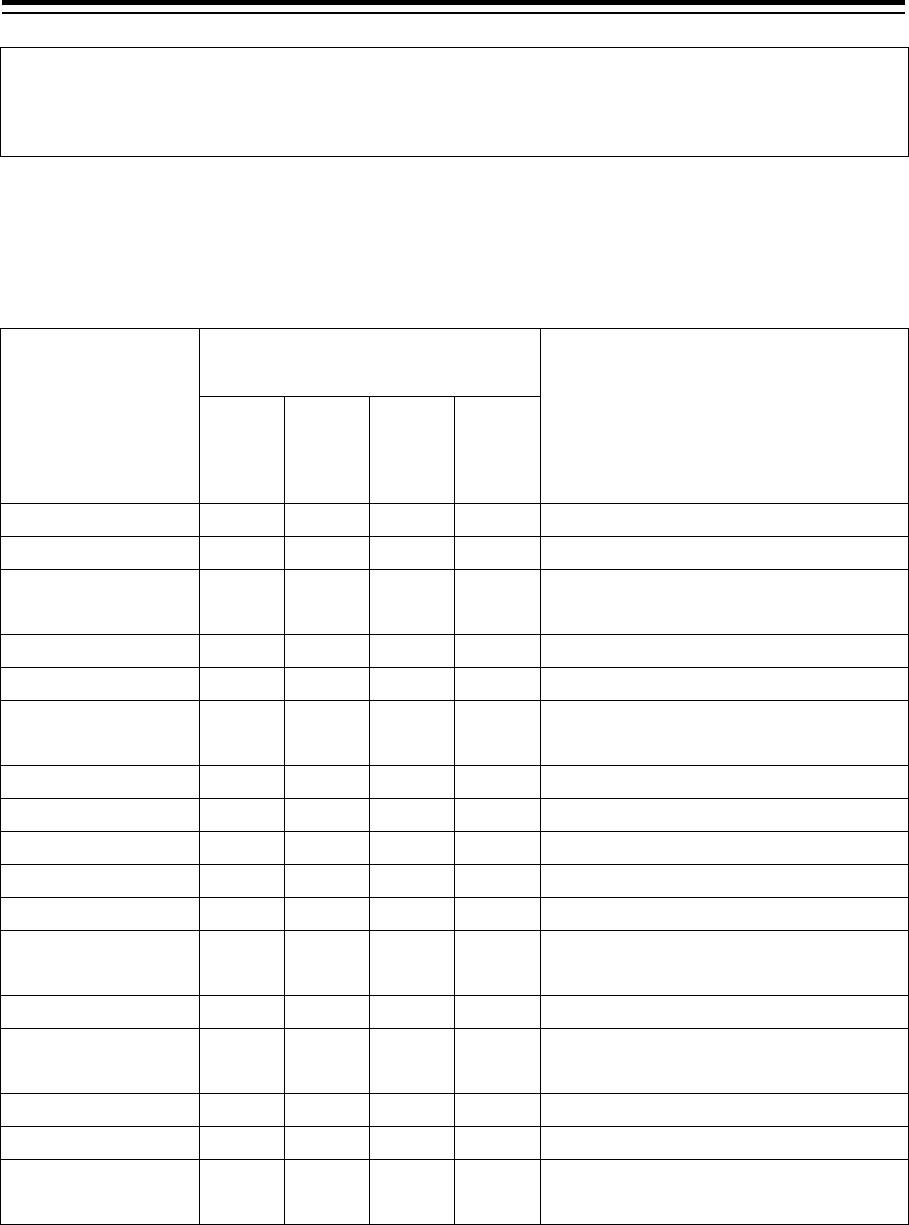
Section 3 Common Basic Operations 3-14
Memo
When the RADAR transmission status is Transmit in RADAR mode and Classification is selected,
the classification pane is hidden automatically.
3.4.2 Menu list
The menus that are displayed vary according to the task that is currently being executed.
Menu
Task that is currently executed
(
: Display -: Hide)
Related section
ECDIS
RADAR
Conning
Playback
Route Planning
-
-
-
Section 9 Route Planning
Route Monitoring
-
Section 10 Route Monitoring
Anchor Watch - - Section 11 Monitoring a Dragging
Anchor
Autosail
*2
-
-
-
Section 12 Automatic Sailing (option)
Chart
*1
-
Section 13 Operating a Chart
User Map - Section 14 Creating a User Map/
Updating a Chart
Logbook
-
-
-
Section 15 Logbook
TT/AIS
-
Section 6 Target Tracking and AIS
Tools
-
-
View
Section 16 Setting Up Screen View
Alert
-
Section 17 Setting Up Alerts
Settings Section 18 Setting Up the Operation
Mode
Chart Maintenance
*1
-
-
13.10 Maintaining a Chart
Maintenance 21.1 Maintenance Functions Executed
from Menu
Help
3.17 Help
Code Input
3.18 Password Input
Service - Section 19 Adjusting and Setting Up
Equipment (for Services)
*1: Displayed when the chart display option is attached to RADAR.
*2: Displayed when the automatic sailing option is attached.
3.4.3 Closing the menu
Click on the [X] button on the menu (submenu).
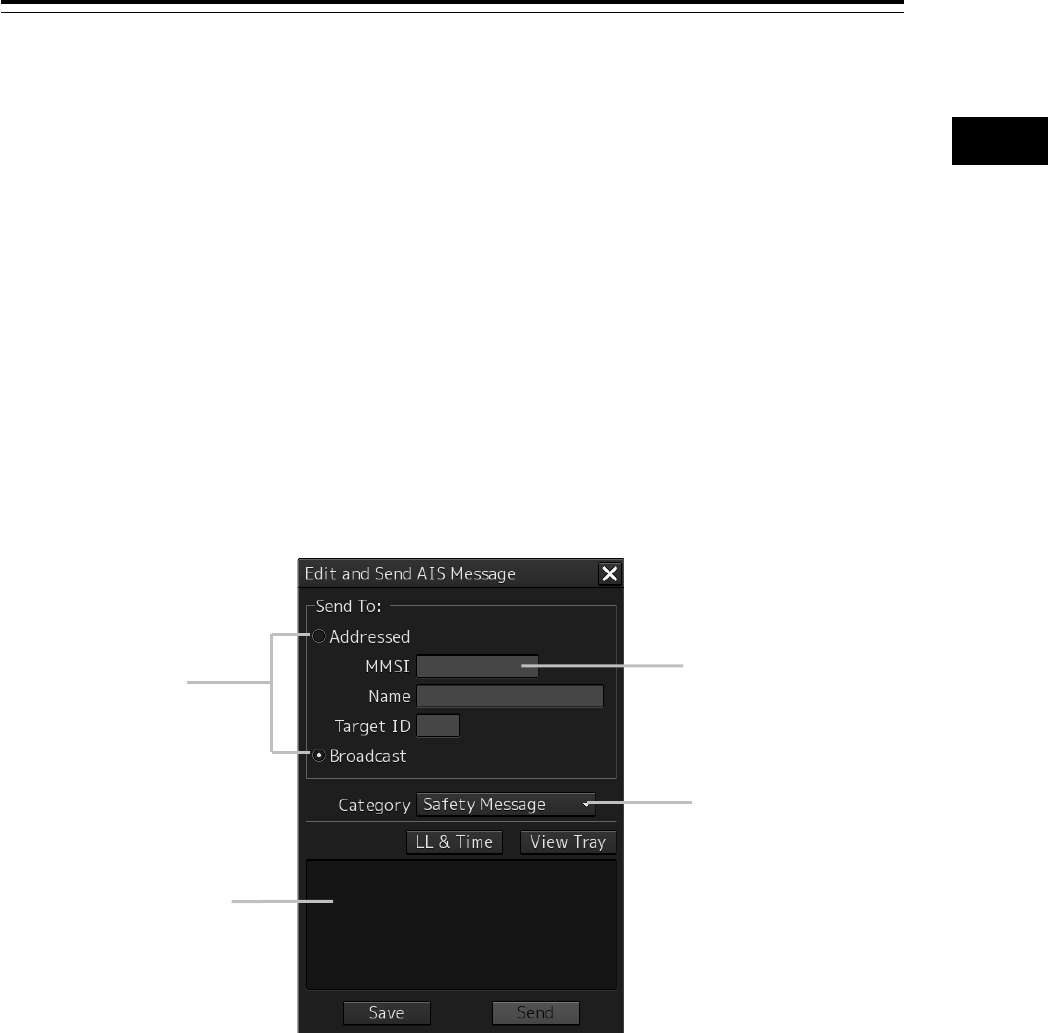
3-15 Section 3 Common Basic Operations
1
2
3
4
5
6
7
8
9
10
11
12
13
14
15
16
17
18
19
20
21
22
23
24
25
APP A
APP B
1
3.5 Basic Dialog Box Operations
When a dialog box is opened, the dialog box is in the factory setting state or state at termination of the
previous operation.
The setting can be changed by the following operation.
• Enter a character or a value in the input box.
• Select a setting from the list.
• Select a setting by clicking on the button.
• Select a setting by checking or unchecking the check box.
3.5.1 Changing dialog box settings
This section describes the basic setting change procedure by using the "Edit and Send AIS Message"
(AIS message editing/transmission) dialog box as the example.
[Addressed]/
[Broadcast] radio
button:
Select whether a MMSI
message is to be sent or
a broadcast message is
distributed by clicking on
the radio button.
Message input area:
Enter a message
(characters).
[MMSI] box:
Enter a MMSI code
(value).
[Message Category]
list: Select [Safety
Message] or [Routine
Message] from the list.
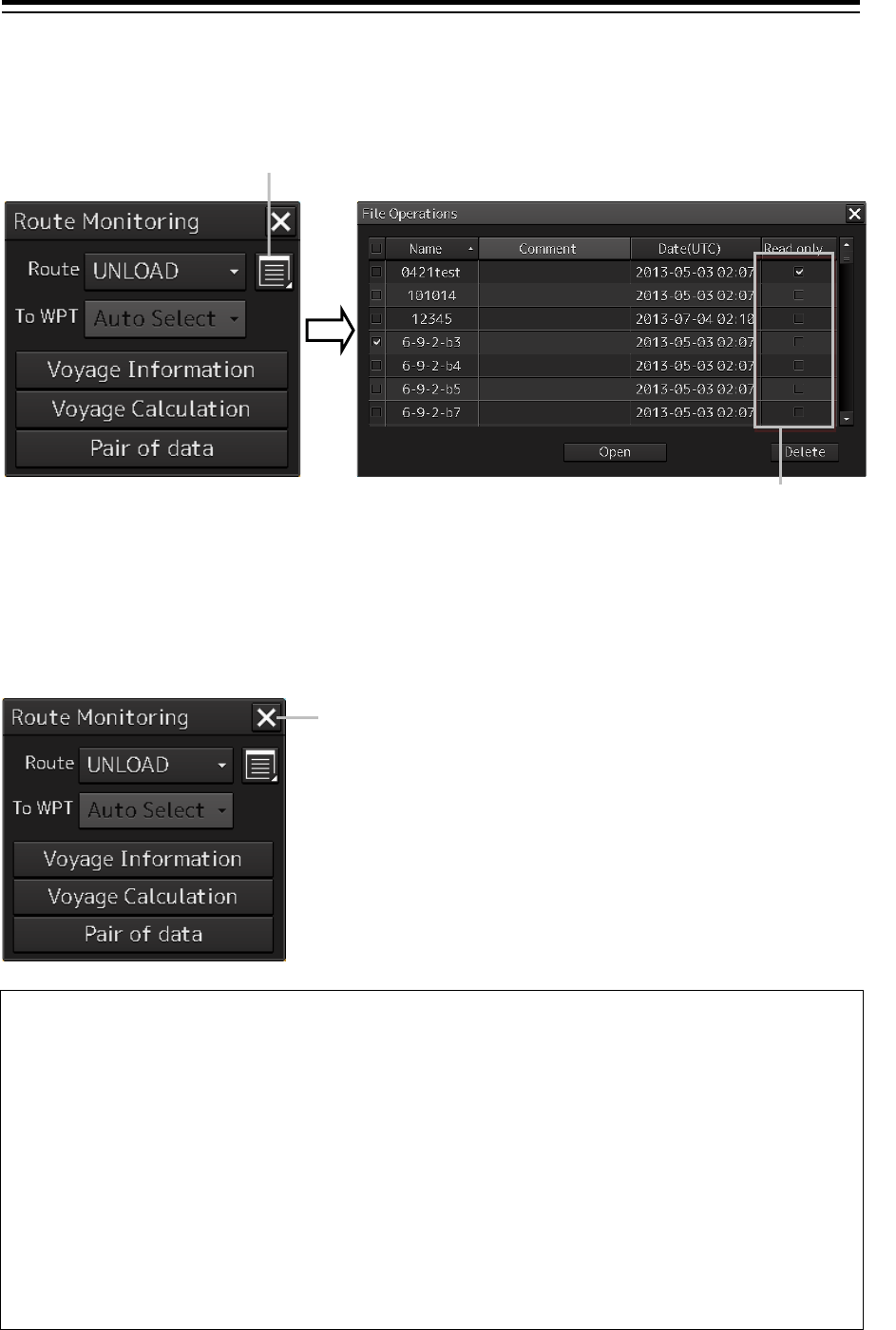
Section 3 Common Basic Operations 3-16
A function may also be set by opening another dialog box from the dialog box.
3.5.2 Closing a dialog box
Close the dialog box by clicking on the [X] (Close) button on the dialog box.
Memo
When no operation is performed for one minute after a dialog*1 is displayed, the dialog is closed
automatically. When a different dialog is displayed in any of the following cases, the dialog that is
currently displayed is closed automatically.
• The RADAR transmission status is Transmit in RADAR mode.
• Automatic sailing or route monitoring is carried out in ECDIS mode.
If setting/editing operation has not been completed when the dialog is closed automatically, the
editing contents are discarded.
*1 The following dialogs are excluded from the targets.
Information monitoring
window, information reference window, route monitoring (including
Voyage Information, Voyage Calculation, and Pair of data), MOB, and Wave Spectrum
[Read only] check box:
Specify the file as [Read Only] by
checking the box by clicking.
File operation dialog box display button:
When this button is clicked on, the "File
operation" dialog box is opened.
[X] button
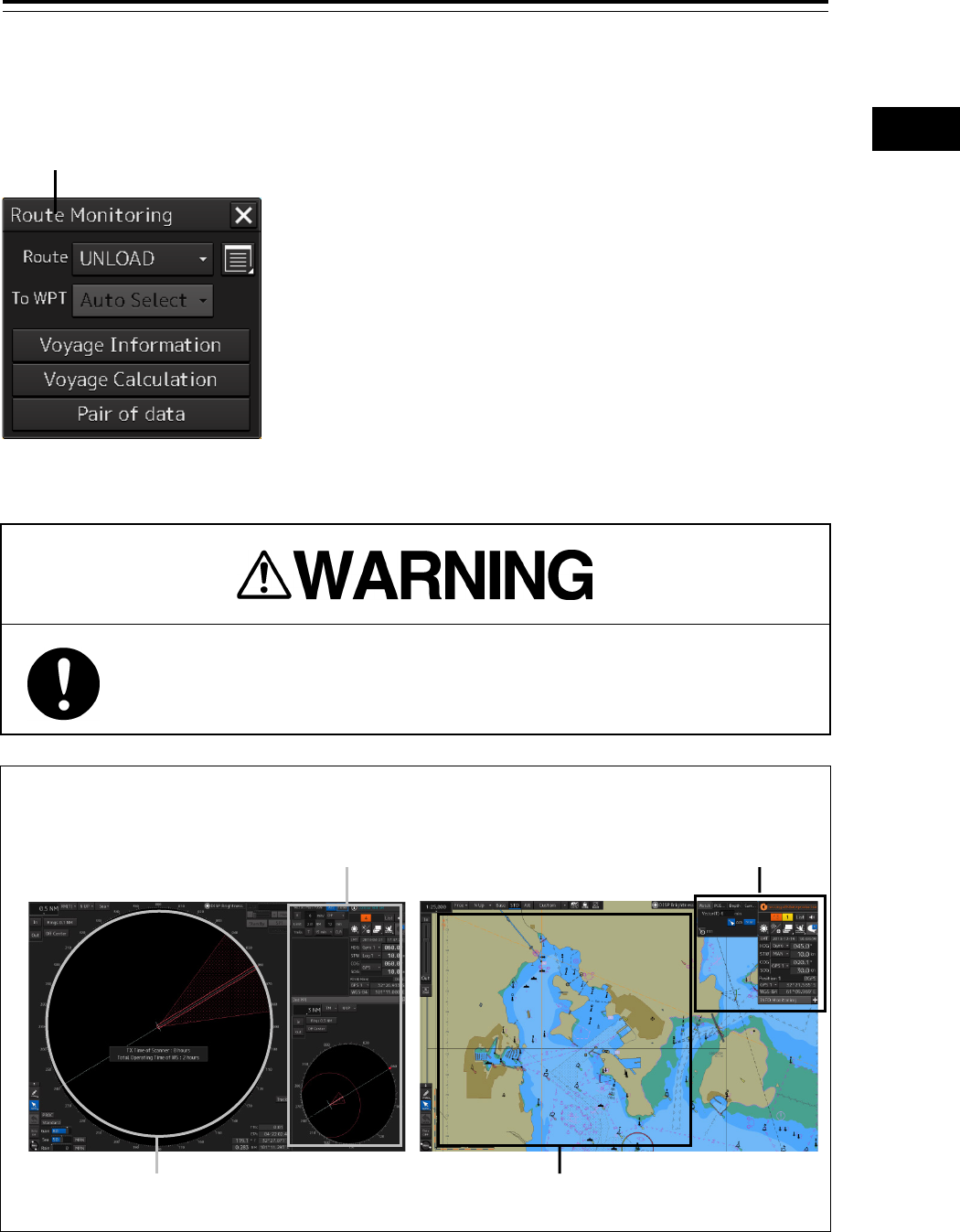
3-17 Section 3 Common Basic Operations
1
2
3
4
5
6
7
8
9
10
11
12
13
14
15
16
17
18
19
20
21
22
23
24
25
APP A
APP B
1
3.5.3 Title Bar
The name (title) of the dialog box is displayed on the title bar of the dialog box.
The dialog can be moved by dragging the title bar.
When moving the dialog, move to the position that does not cover the operation area.
If the dialog covers the operation area, it may interrupt the recognition of the display
information.
Memo
Operation area and user dialog area
Title of the dialog box
Operation area
Operation area
User dialog area
User dialog area
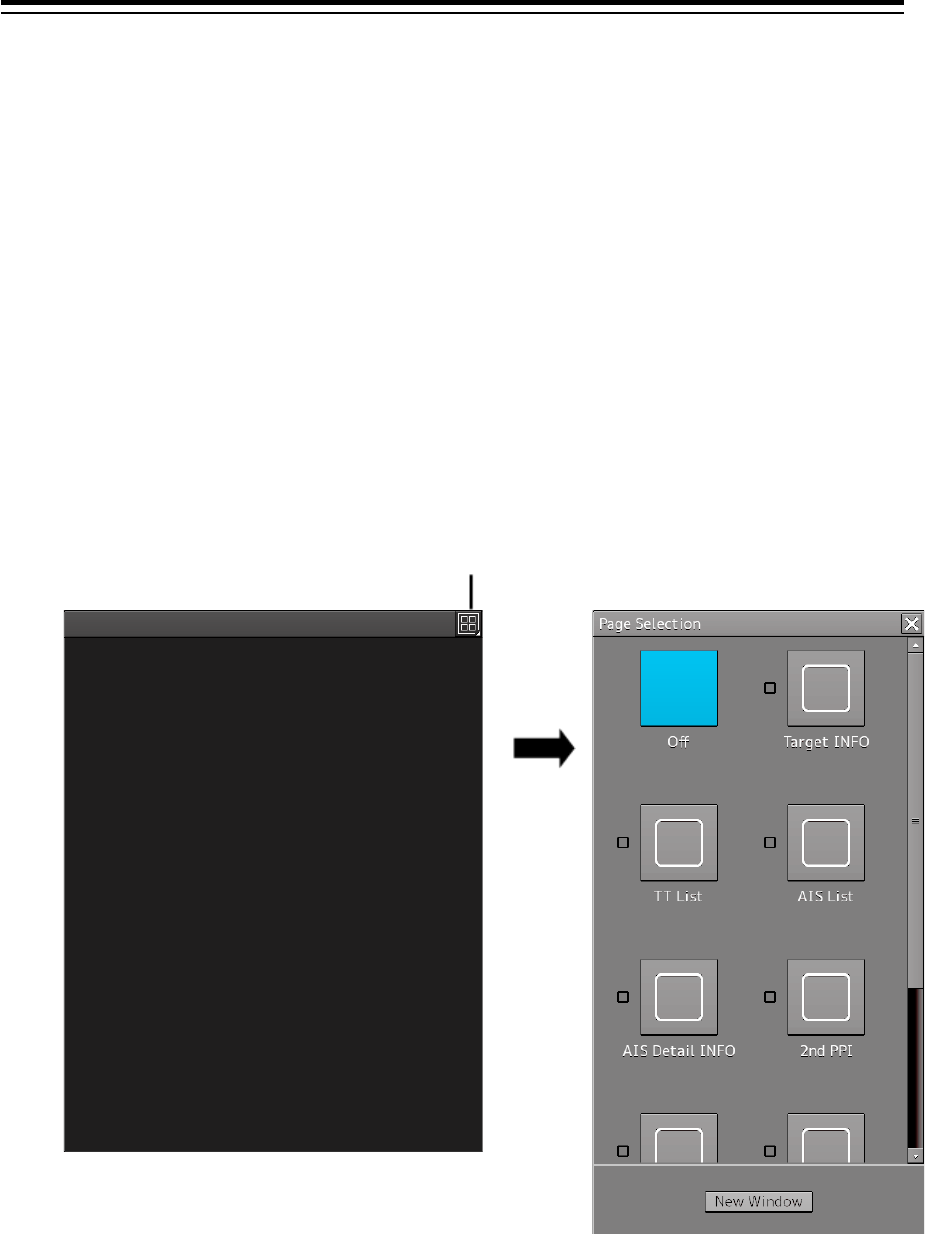
Section 3 Common Basic Operations 3-18
3.6 Operation of the Information Monitor
Window
This section describes the operation and editing of the information monitor window.
For the details of the information monitor window, refer to "2.3 Common Information Window".
3.6.1 Opening the information monitor window
1 Click on the page switching button on the initial display window.
In the initial display, a blank window appears.
The "Page Selection" dialog box appears by clicking on the page switching button.
[For RADAR]
Page switching button
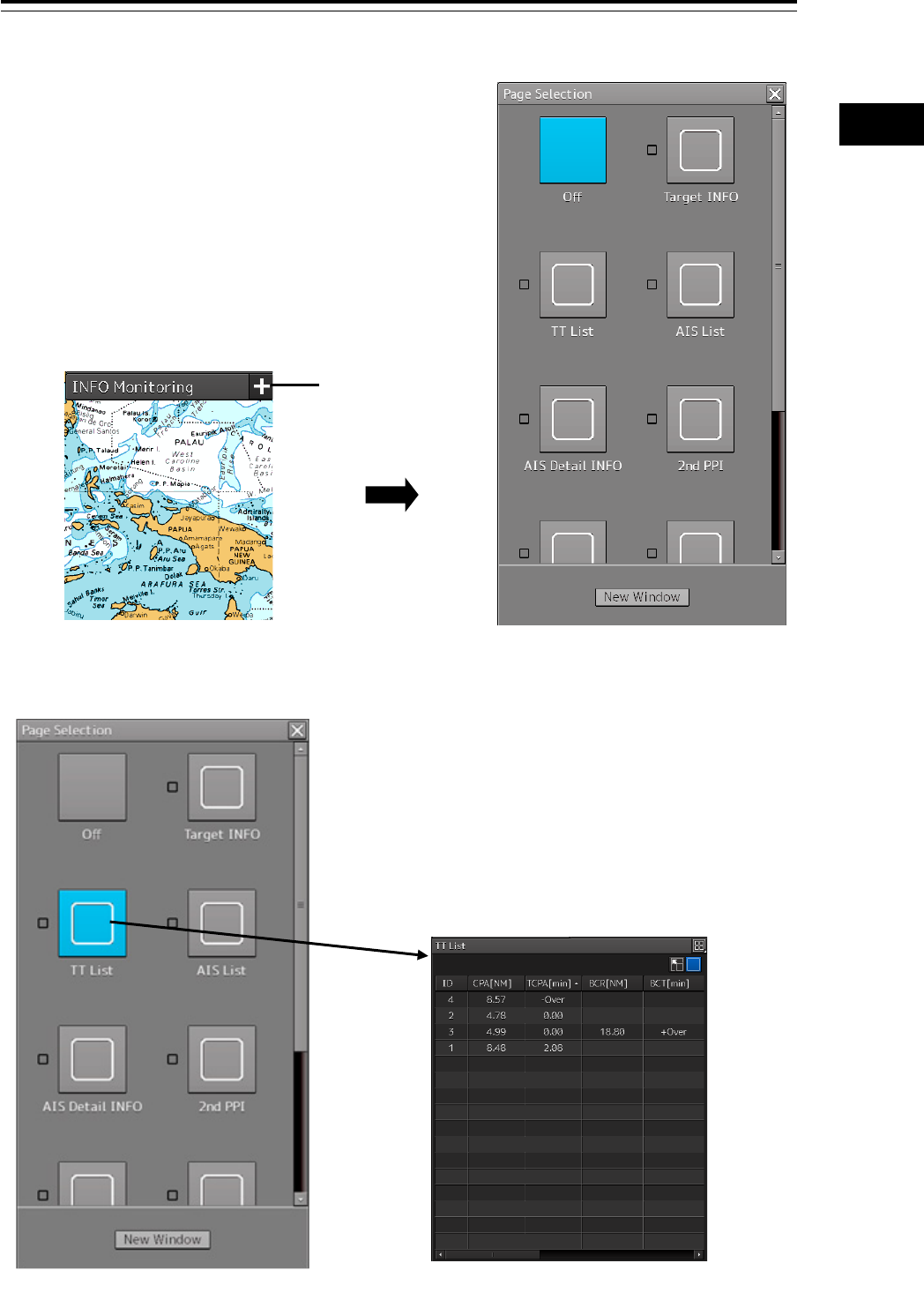
3-19 Section 3 Common Basic Operations
1
2
3
4
5
6
7
8
9
10
11
12
13
14
15
16
17
18
19
20
21
22
23
24
25
APP A
APP B
1
[For ECDIS]
2 Click on the monitor information to be displayed. The applicable window is opened.
Page switching button
Example: When selecting the TT List in the RADAR
Click.
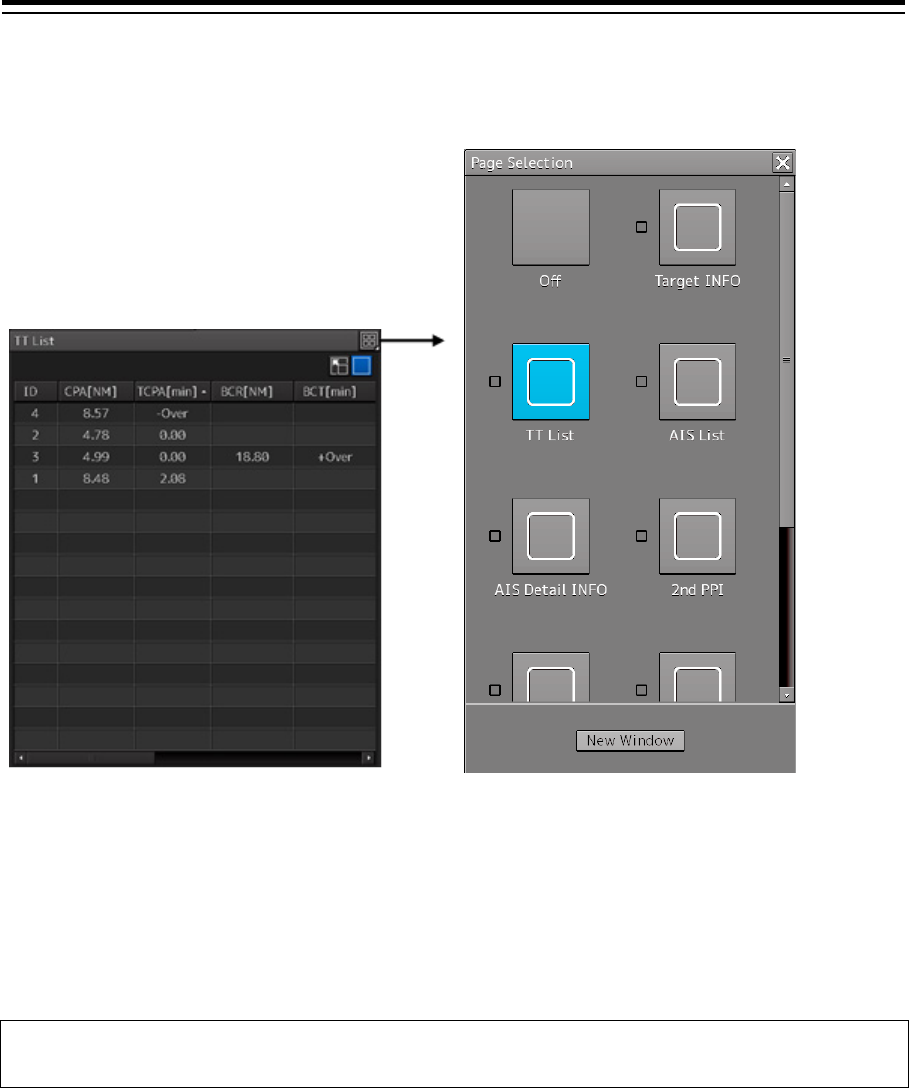
Section 3 Common Basic Operations 3-20
Returning to the "Page Selection" dialog box from each window
When the page switching button on each window is clicked on, control returns to the "Page Selection"
dialog box.
Setting another window for the item (ECDIS only)
1 Select the checkbox for the item for which another window is to be set.
2 Click on the [New Window] button.
The item is displayed on another window.
Memo
The window that is already displayed cannot be set to another window.
Example: Returning control from Target INFO in the RADAR
Click.

3-21 Section 3 Common Basic Operations
1
2
3
4
5
6
7
8
9
10
11
12
13
14
15
16
17
18
19
20
21
22
23
24
25
APP A
APP B
1
3.6.2 Displaying an information monitor window
from other than the "Page Selection" dialog
box
Use the following procedures to display an information monitor window from a display other than the
"Page Selection" dialog box.
Information monitor
window Display method
Target INFO 1) Click on the TT symbol. (Cursor AUTO mode)
2) Click the right button on the TT/AIS symbol and select Readout
information from the context menu.
3) Click on the AIS Activated target. (Cursor AUTO mode)
TT List (RADAR)
TT1 List, TT2 List (ECDIS)
1) Select TT/AIS List from [TT/AIS] on the menu.
AIS List 1) Select TT/AIS List from [TT/AIS] on the menu.
AIS Detail INFO 1) Select one AIS target from the AIS List and click on the Details
button.
2) Click the right button on the AIS symbol, and select Readout detail
information from the context menu.
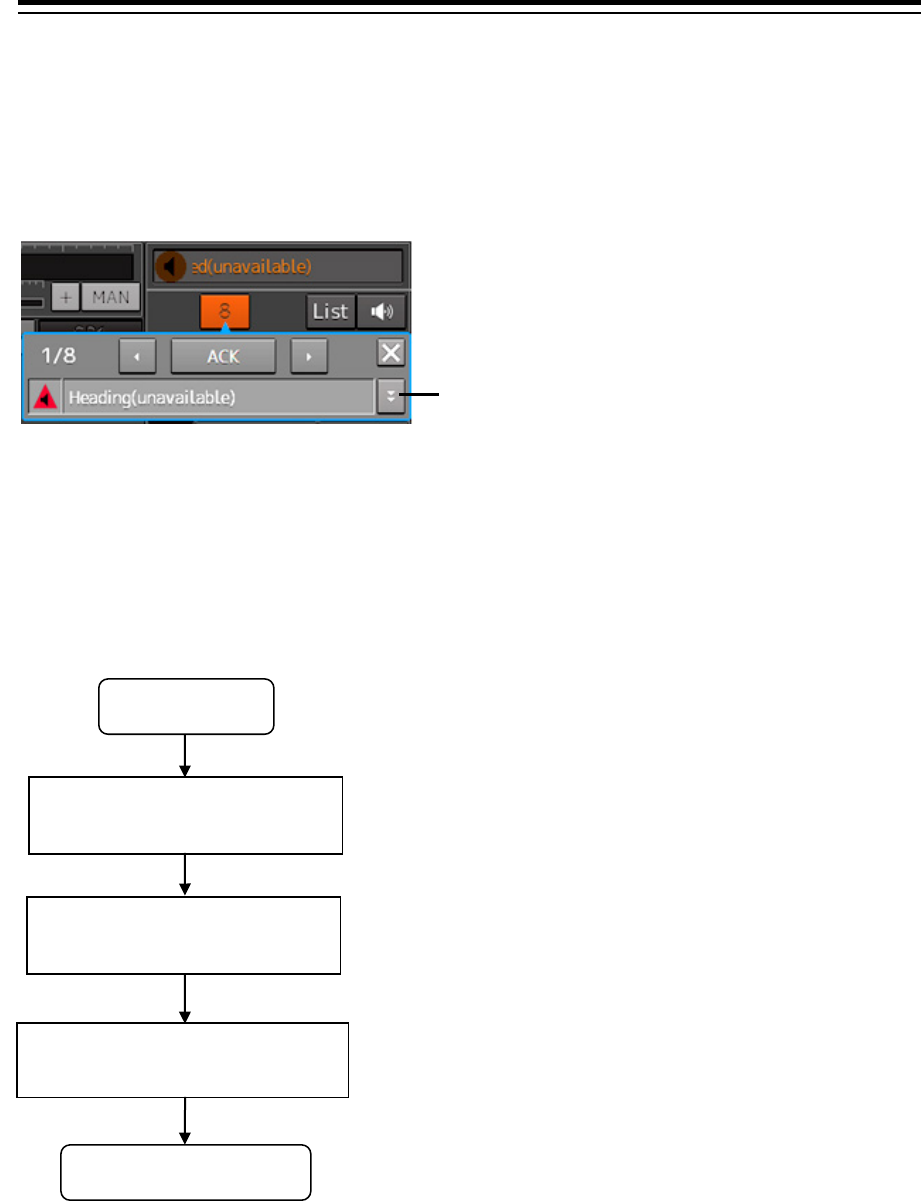
Section 3 Common Basic Operations 3-22
3.7 Confirming and Acknowledging an
Alert
When an alert occurs, a buzzer sound is emitted and an alert balloon is displayed in the alert
notification area.
To acknowledge the alert detailed information, click on the Disclosure button.
For the details of the subsequent operations, refer to "3.7.2 Confirming alert contents".
The general procedure for handling an alert is shown below.
Example of alert balloon
Disclosure button
Alert generation
Stop the buzzer
"3.7.1 Stopping a buzzer"
Acknowledge the alert
"3.7.3 Acknowledging the alert"
Check the alert contents
"3.7.2 Confirming alert contents"
Resolve the alert cause
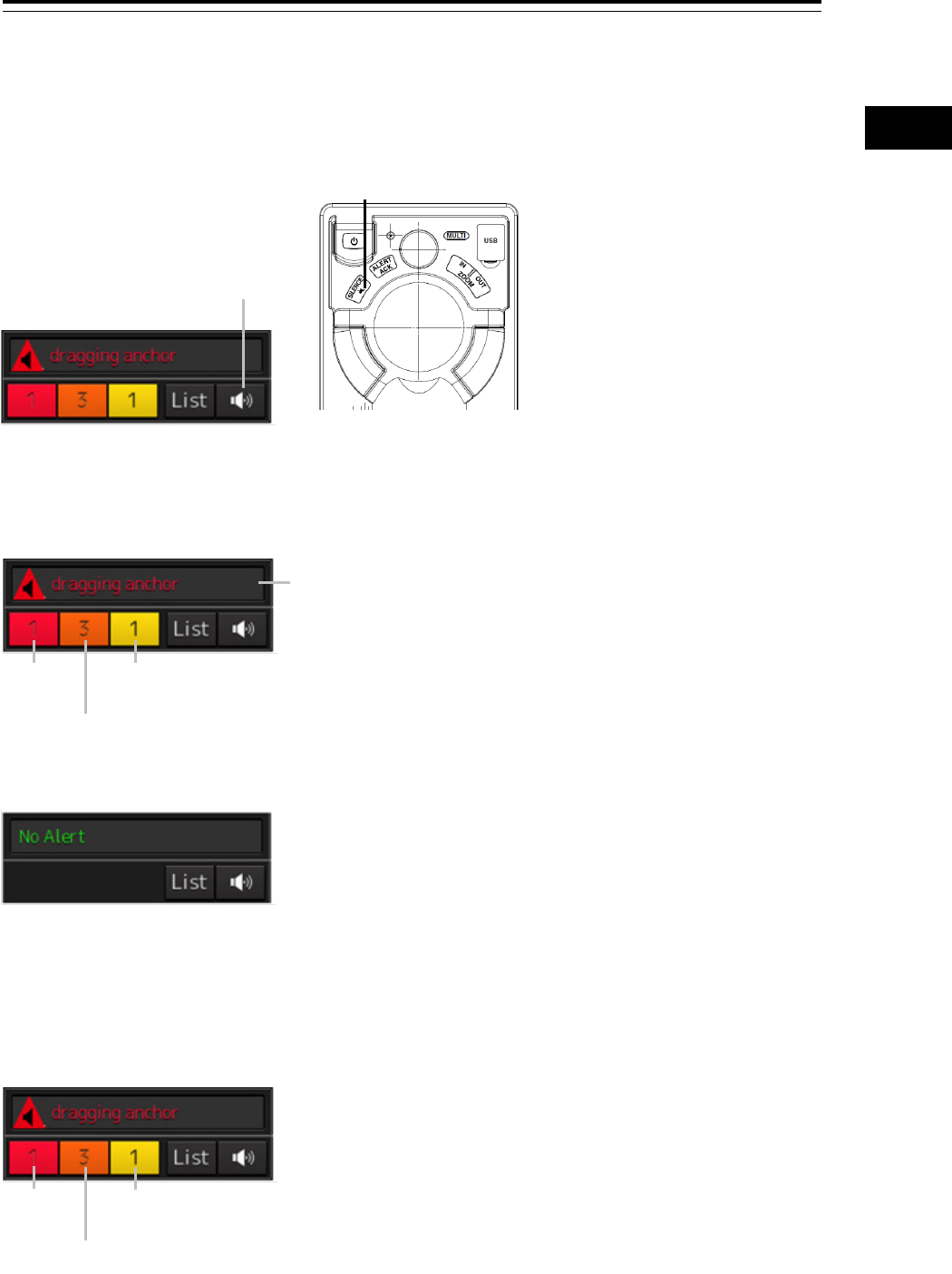
3-23 Section 3 Common Basic Operations
1
2
3
4
5
6
7
8
9
10
11
12
13
14
15
16
17
18
19
20
21
22
23
24
25
APP A
APP B
1
3.7.1 Stopping a buzzer
To stop a buzzer (silencing), click the silence button in the alert notification area or press the
[SILENCE] key in the trackball operation unit.
3.7.2 Confirming alert contents
Display Example when an Alert is generated
Display Example when No Alert is generated
When an alert is generated, the alert message is displayed in the "Alert status area".
The alert type and the number of alerts are displayed by the button.
[SILENCE] key
Silence button
Warning button
Alert status area
Caution button
Alarm
button
Warning button
Caution button
Alarm
button
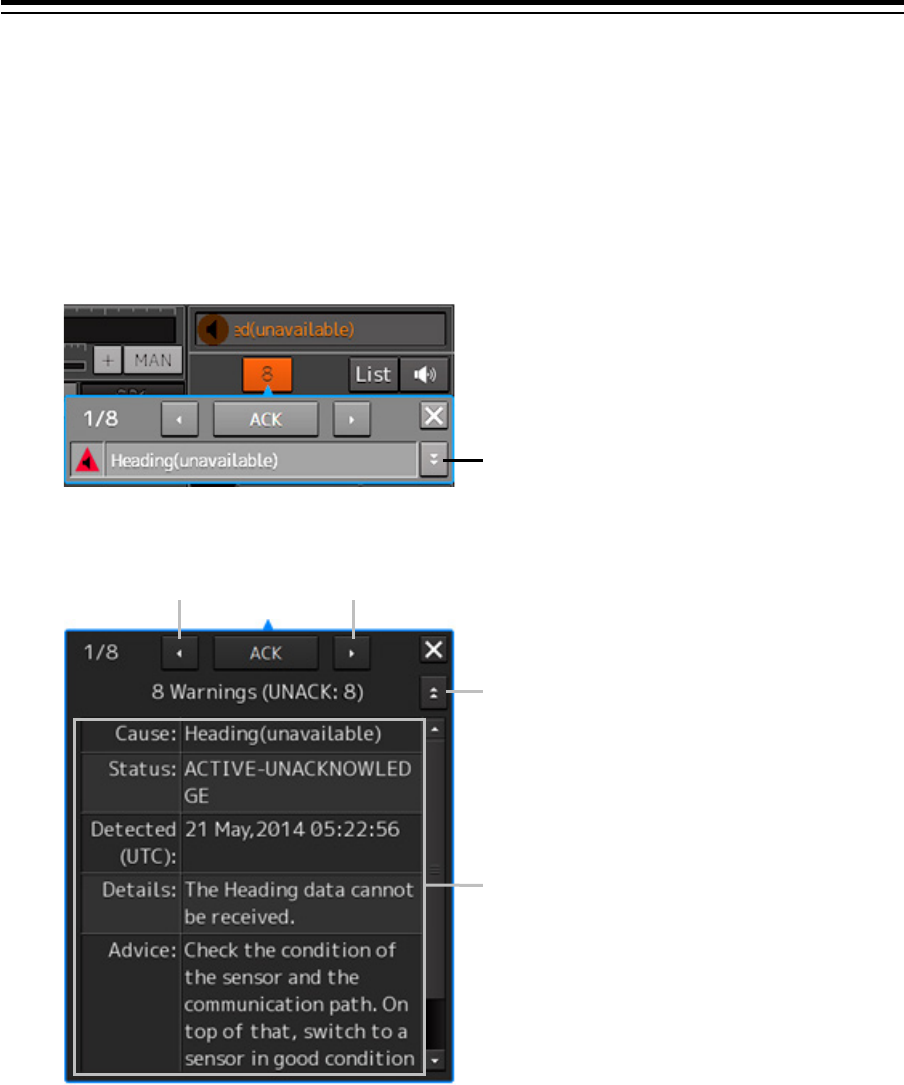
Section 3 Common Basic Operations 3-24
• Alarm button: Displayed when an alarm is generated. The button is displayed in red. The
number of alarms is indicated on the button
• Warning button: Displayed when a warning is generated. The button is displayed in orange. The
number of warnings is indicated on the button.
• Caution button: Displayed when a caution is generated. The button is displayed in yellow. The
number of cautions is indicated on the button.
1 Click on the button
An alert balloon is displayed.
2 Display the alert detail dialog by clicking on the Disclosure button.
[1] [Higher] button
When the Higher button is clicked on, details of the alerts of the higher priority than the alert currently
displayed appear.
[2] [Lower] button
When the Lower button is clicked on, details of the alerts of the lower priority than the alert currently
displayed appear.
[3] Disclosure button
When the Disclosure button is clicked on, the original alert balloon is displayed.
As a result, the Own Ship Information that was hidden can be re-acknowledged.
Disclosure button
[1]
[2]
[3]
[4]

3-25 Section 3 Common Basic Operations
1
2
3
4
5
6
7
8
9
10
11
12
13
14
15
16
17
18
19
20
21
22
23
24
25
APP A
APP B
1
[4] Detail information
Cause, Status, Date and time (Raised), Details and action (Advice) to be taken are displayed.
Memo
About Information:
Information is displayed in addition to a warning or a caution in the alert status area.
Information is used to report operation errors and so on to the users.
Unlike other alerts, no detail display is provided for Information.
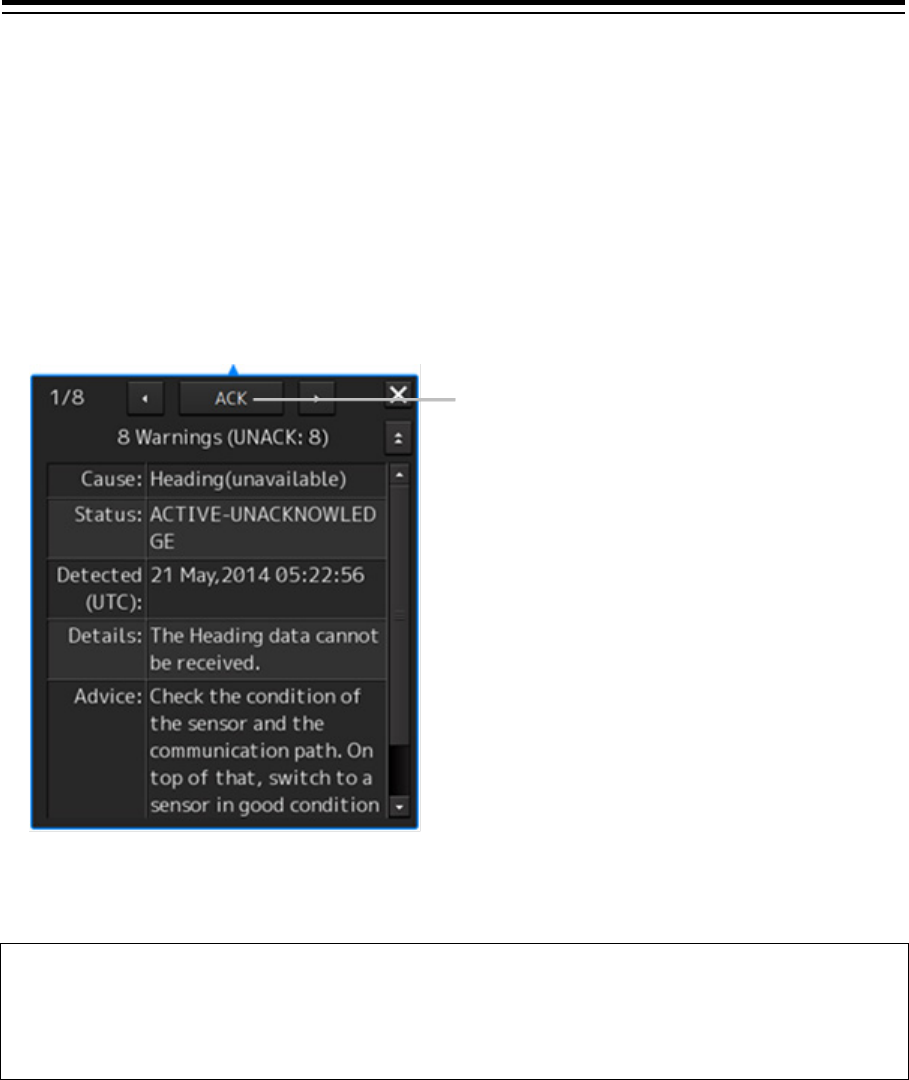
Section 3 Common Basic Operations 3-26
3.7.3 Acknowledging the alert
After the [ACK] (acknowledgement) button of the alert detail display dialog box is clicked on or the
[ALERT ACK] (alert acknowledgement) button of the trackball operation section is pressed after
verification of the alert contents, the alert that is currently displayed is acknowledged.
When there are multiple alerts, perform the same operation by displaying the details dialog box of
another alert.
When all the alerts are acknowledged, the alert detail display dialog is closed automatically.
Memo
An alert can also be acknowledged by clicking on the [Active Alert] tab - [ACK] button of the "Alert
List" dialog box.
For the details, refer to "3.7.4 Displaying Alert List and Alert History".
[ACK] button
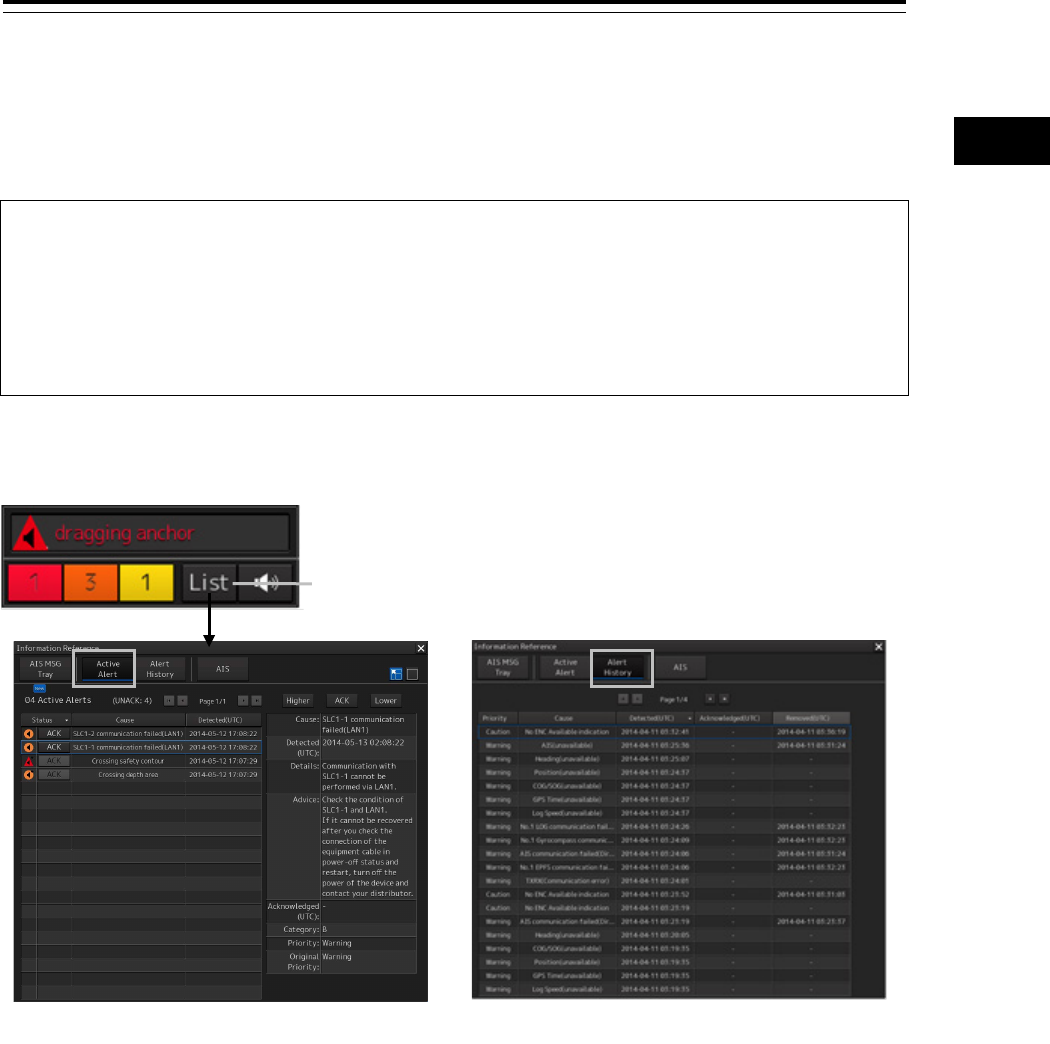
3-27 Section 3 Common Basic Operations
1
2
3
4
5
6
7
8
9
10
11
12
13
14
15
16
17
18
19
20
21
22
23
24
25
APP A
APP B
1
3.7.4 Displaying alert list and alert history
When an alert list button is clicked on, the "Alert List" dialog box of the common information window is
displayed.
Memo
The common information window can be switched to either the standard window display or the
enlarged window display.
This section uses the enlarged window in the example.
Fort the details of switching between the standard window and the enlarged window, refer to
"2.3.2.1 Switching between a standard window and an extended window".
In the "Active Alert" tab, a list of the current alerts is displayed. In the "Alert History" tab, a list of past
alerts that have been resolved is displayed.
Alert list button
"Active Alert" Tab of the "Alert List" Dialog Box "Alert History" Tab of the "Alert List" Dialog Box
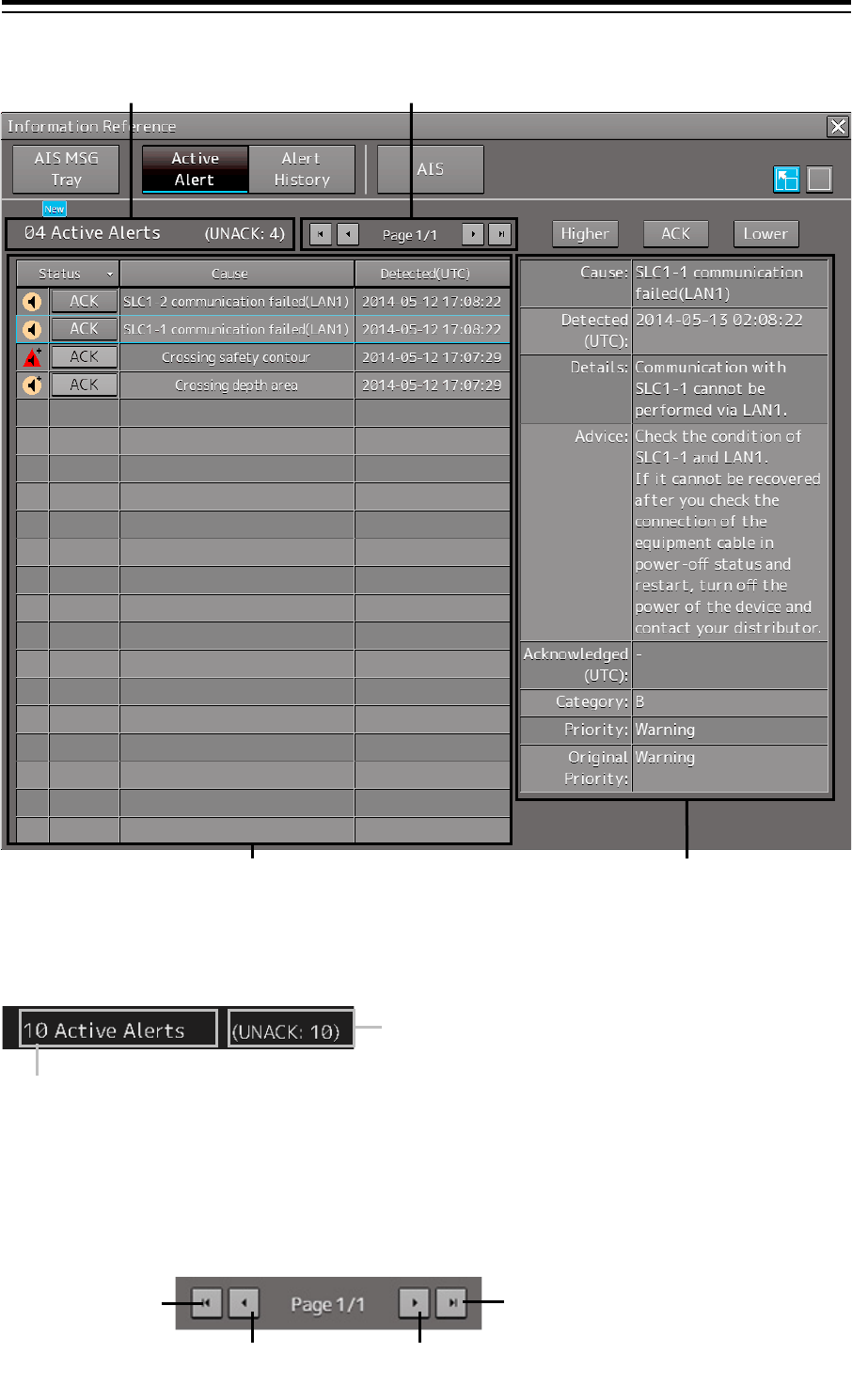
Section 3 Common Basic Operations 3-28
["Active Alert" tab]
[1] Active alert information
The number of current alerts is displayed.
[2] Active page information
Up to 20 alert information items can be displayed in one page. Use this function to switch pages when
the number of alert information items exceeds 20, requiring multiple pages.
Number of alerts
Number of unacknowledged alerts
Move to the
first page
Move to the last page
Move to the previous page
Move to the next page
[1]
[4]
[2]
[3]
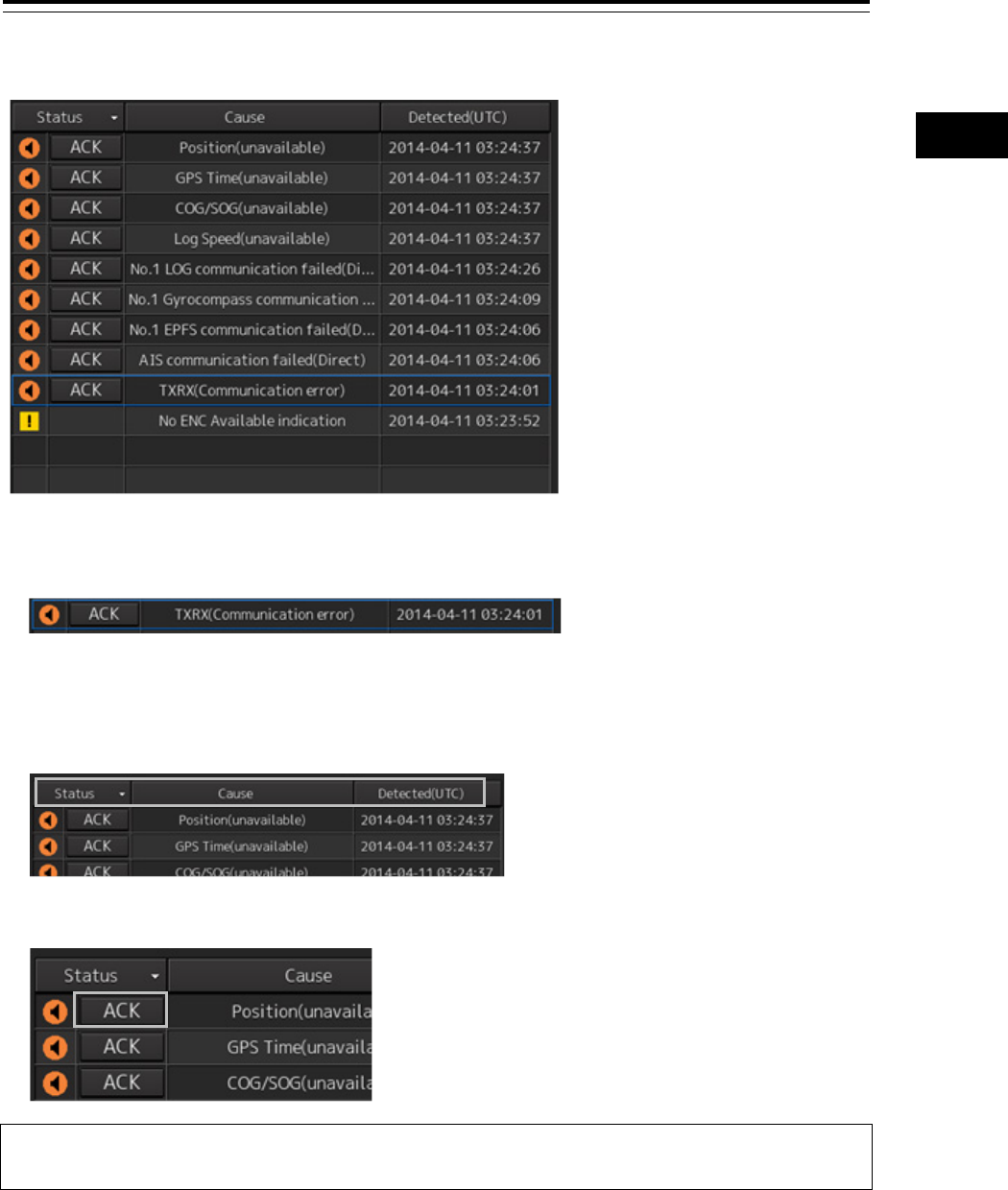
3-29 Section 3 Common Basic Operations
1
2
3
4
5
6
7
8
9
10
11
12
13
14
15
16
17
18
19
20
21
22
23
24
25
APP A
APP B
1
[3] Active alert list
• The alert of the highest priority is automatically selected. When an alert in the active alert list is
clicked on, the alert is selected.
• The details of the selected alert are displayed in "[4] Active alert details".
• When a new alert is generated during the screen display, the alert is added at the top of the list.
• By clicking on any of the items in the title line, active alerts can be sorted based on the item.
• When the [ACK] button is clicked on, the alert is acknowledged.
Memo
The [ACK] button is not displayed for the [Caution] alert since acknowledgement is not required.
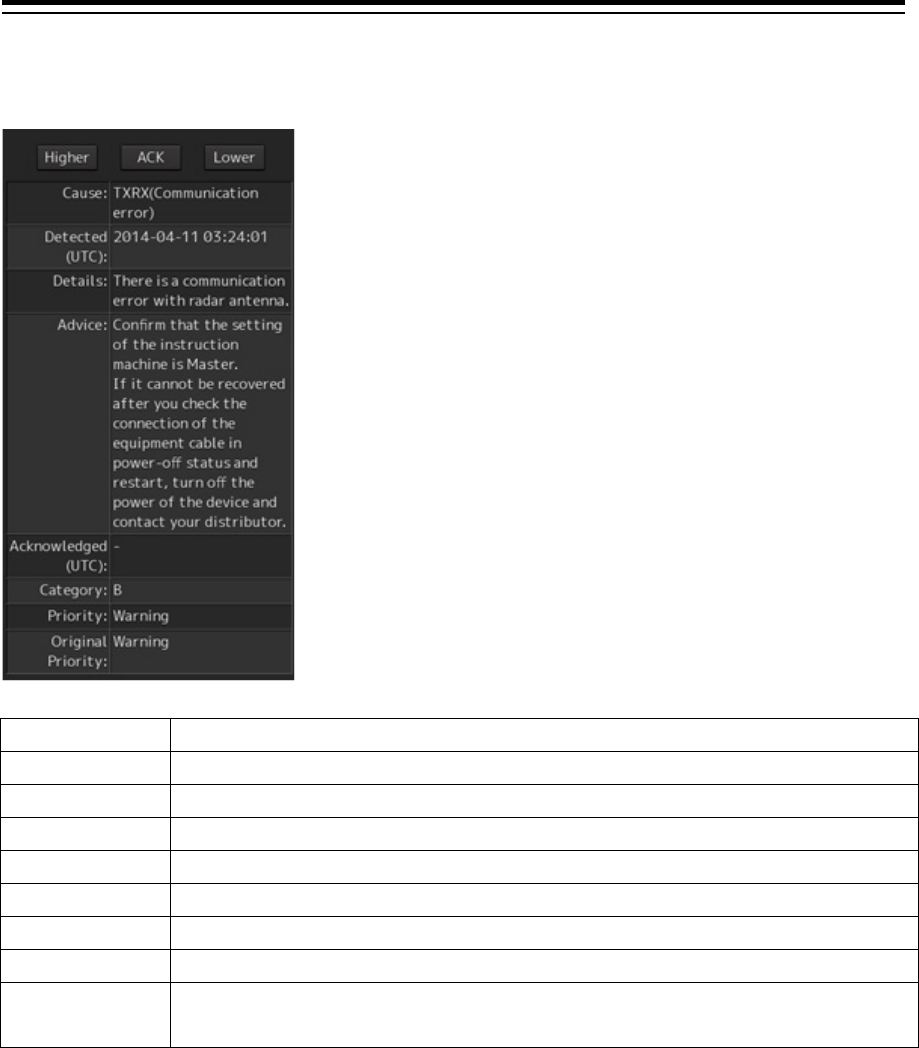
Section 3 Common Basic Operations 3-30
[4] Details of active alert
Details of the alert that is currently selected are displayed.
Alert
Detailed information
Cause:
Displays the cause of the alert.
Raised:
Displays the alert generation time.
Details:
Displays the details of the cause of the alert.
Advice:
Displays advice on the alert (action to be taken by the user).
Acknowledged:
Displays the time when the alert was acknowledged.
Category:
Displays the alert category.
Priority:
Displays the current alert priority (identification of Alarm/Warning/Caution).
Original Priority: Displays the priority (identification of Alarm/Warning/Caution) at the generation of
the alert.
[Higher] button
When this button is clicked on, the details of the alert of the higher priority than the alert that is currently
displayed appear.
[Lower] button
When this button is clicked on, the details of the alert of the lower priority than the alert that is currently
displayed appear.
[ACK] button
When this button is clicked on, the alert that is currently selected is acknowledged.
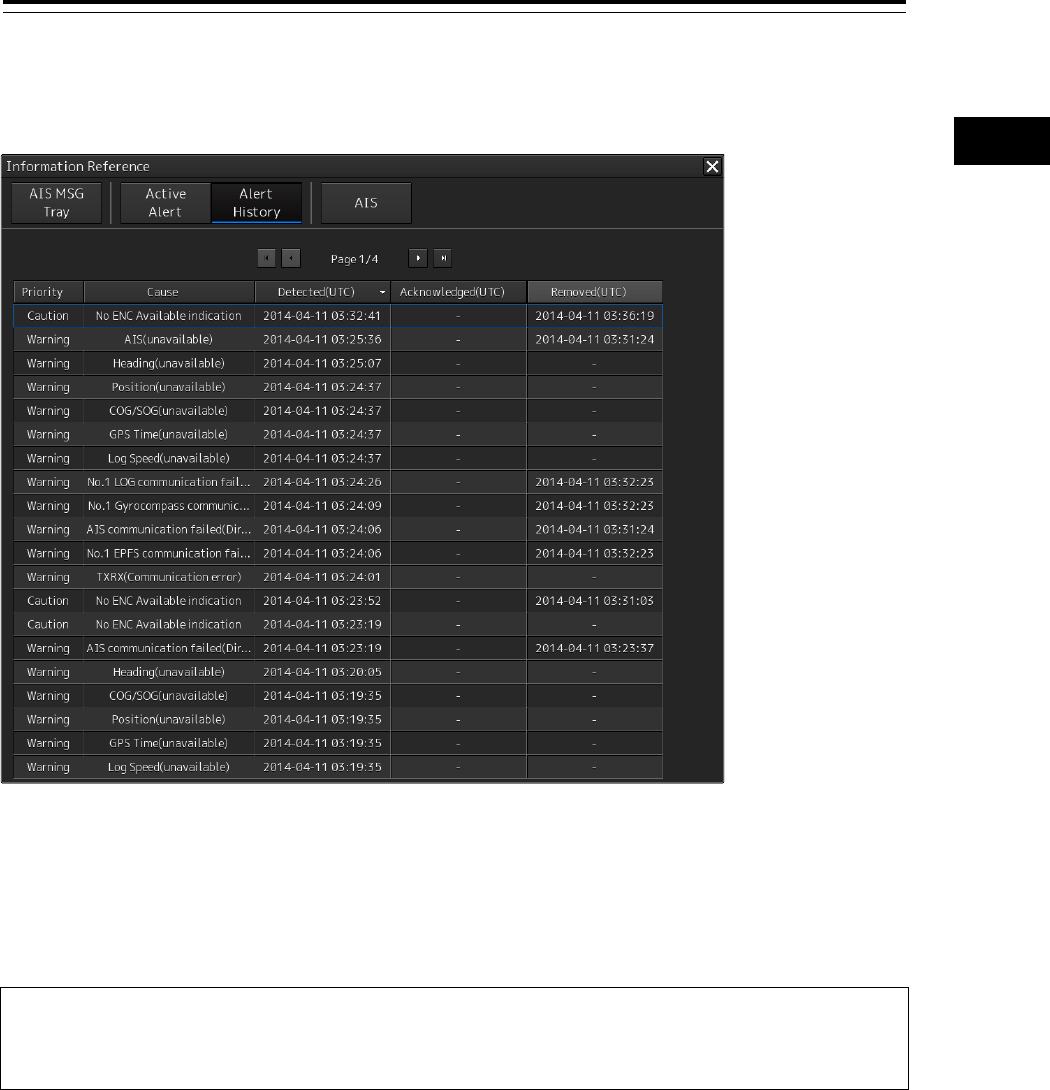
3-31 Section 3 Common Basic Operations
1
2
3
4
5
6
7
8
9
10
11
12
13
14
15
16
17
18
19
20
21
22
23
24
25
APP A
APP B
1
["Alert History" tab]
Alerts that have been generated in the past are displayed.
• Up to 20 alerts are displayed per page.
• When a newly acknowledged alert is generated during the screen display, the acknowledged alert is
added to the top of the list.
• By clicking on any of the items in the title line, active alerts can be sorted based on the item.
Memo
The Alert History screen is displayed under the extended window only. A standard window is not
available.
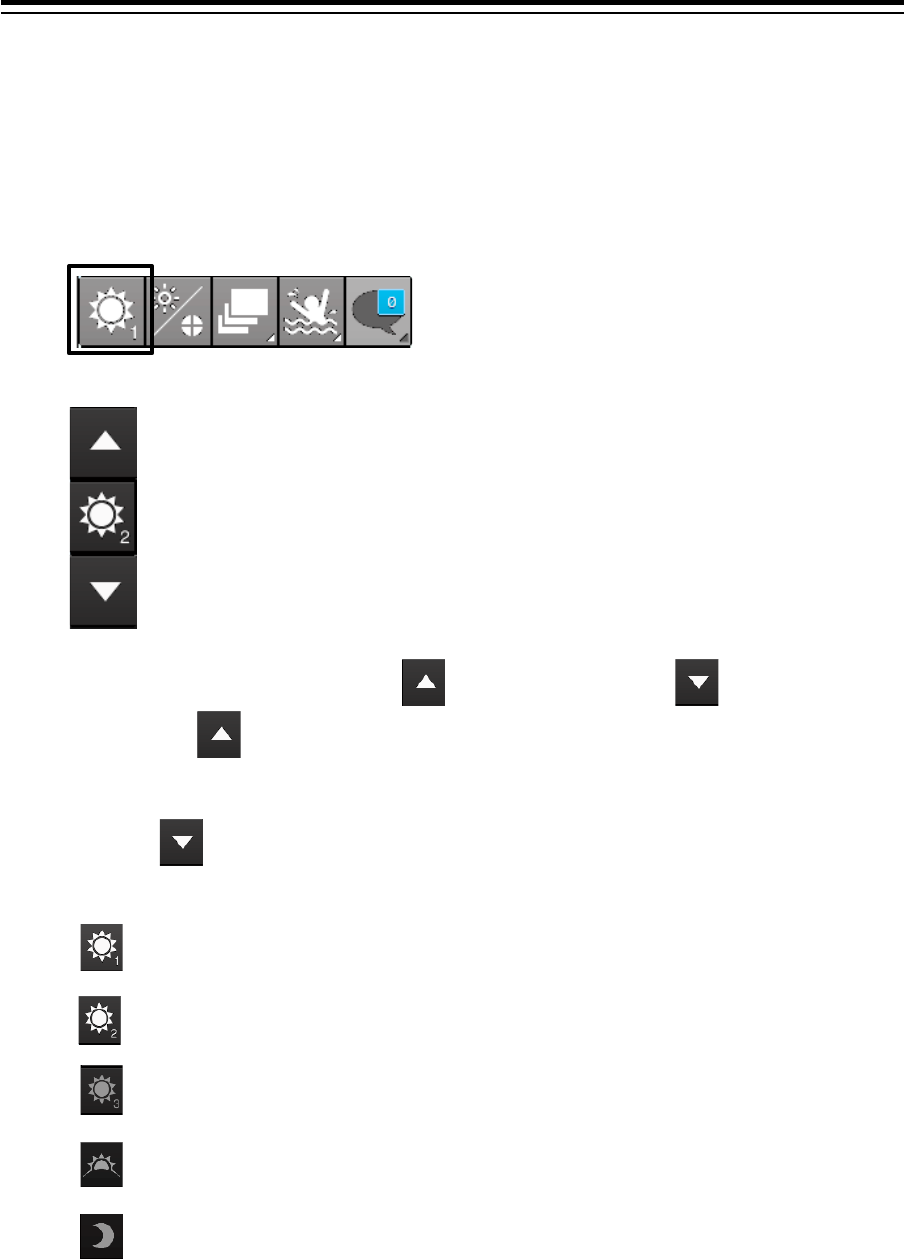
Section 3 Common Basic Operations 3-32
3.8 Switching the Day/Night Mode
The screen display color can be switched to any of five levels according to the brightness within the
bridge.
Use the following procedure for switching.
1 Click on the Day/Night button on the right toolbar.
Adjustment buttons are displayed based on the brightness that is currently set.
2 Adjust the brightness by using the [Light] button and the [Dark] button.
Whenever the [Light] button is clicked on, the brightness increases by one level from the
current level.
When the [Dark] button is clicked on, the brightness decreases by one level from the
current level.
: Day 1
: Day 2
: Day 3
: Dusk
: Night
Example: Day2 is set.
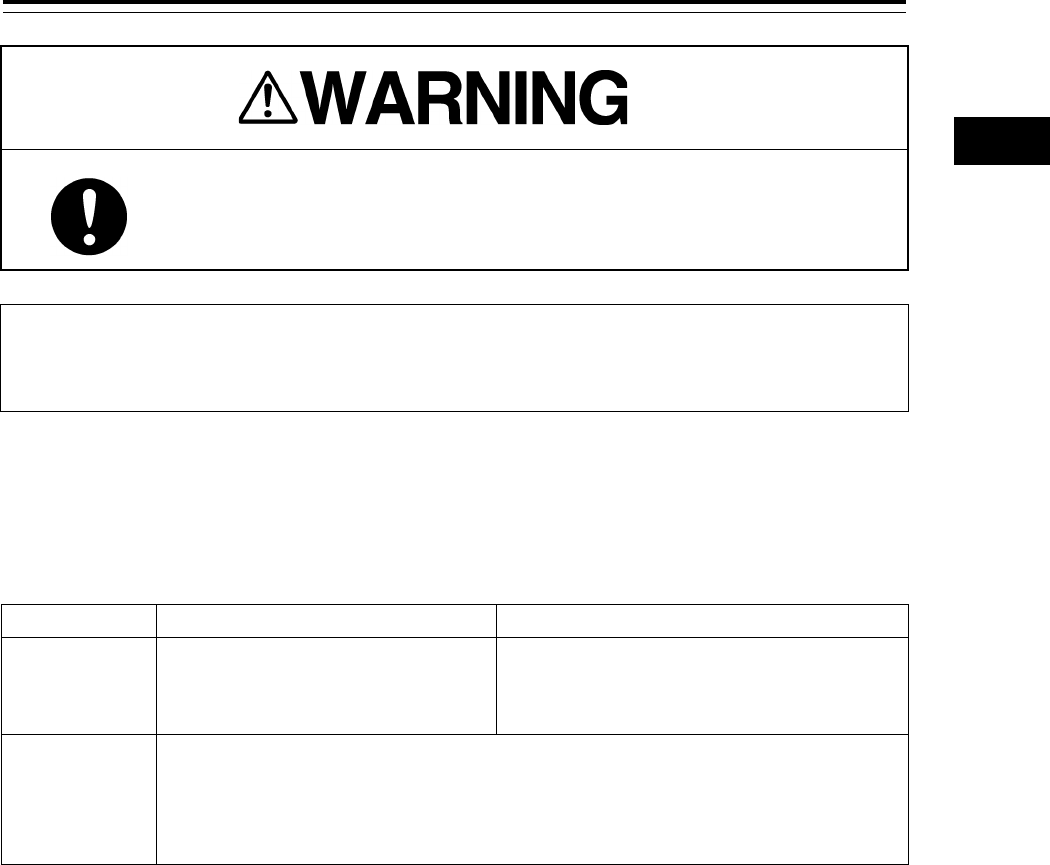
3-33 Section 3 Common Basic Operations
1
2
3
4
5
6
7
8
9
10
11
12
13
14
15
16
17
18
19
20
21
22
23
24
25
APP A
APP B
1
Change of the color of the Day/Night button, particularly the use of the
[Night] color, may interfere with the recognition of display information.
Memo
The colors and brightness of the buttons can be changed by setting [Settings] - [
Color and
Brightness] in the menu. For the details, refer to "18.18 Setting Color and Brilliance".
Relationship between the day/night mode and the screen/operation section
brightness setting value
When the day/night mode is changed, the screen/operation section brightness is set to the following
values.
26-inch monitor
19-inch monitor
Screen
brightness
Day1, Day2, Day3: 67/100
Dusk: 60/100
Night: 11/100
Day1, Day2, Day3: 42/100
Dusk: 20/100
Night: 4/100
Operation unit
brightness
Day1: Level4
Day2: Level3
Day3: Level2
Dusk, Night: Level1
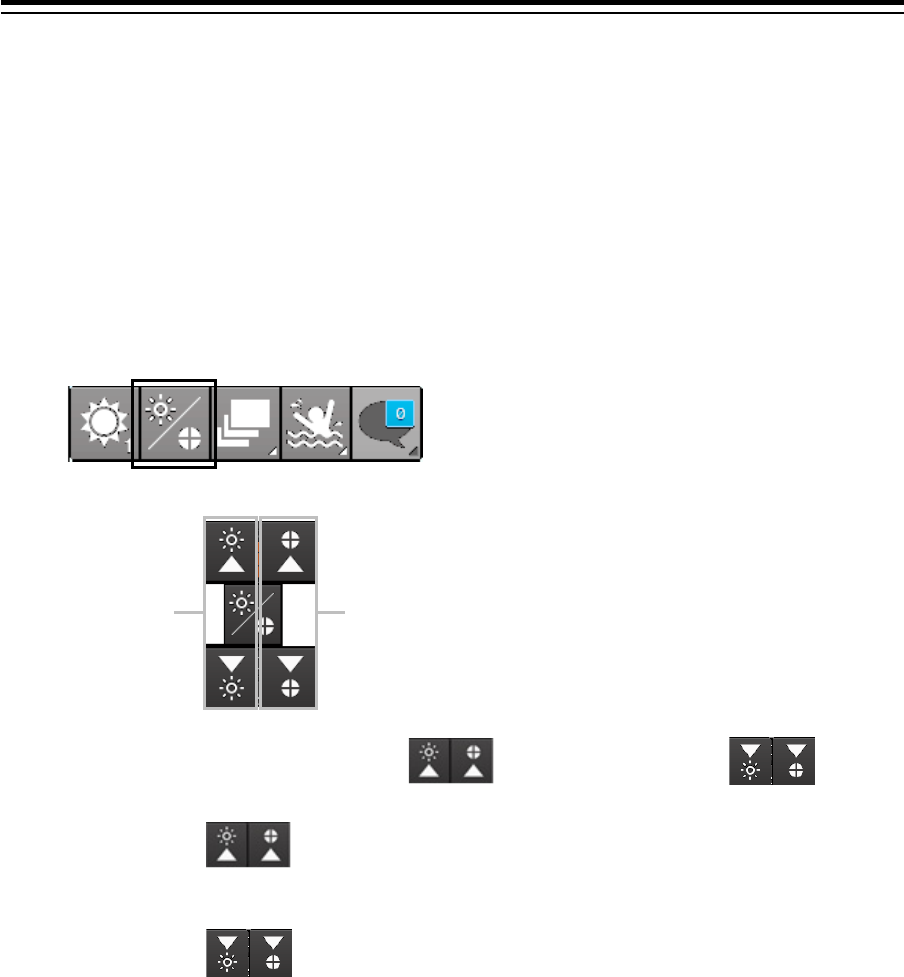
Section 3 Common Basic Operations 3-34
3.9 Adjusting the Brightness of the
Screen and Operation Unit
The brightness of the screen and the operation section can be adjusted.
The screen brightness can be adjusted within the range from 0 to 100.
The brightness of the operation section can be adjusted in 5 levels (0 to 4).
Use the following procedure for adjusting the brightness.
1 Click on the Display and Panel Brightness button on the right toolbar.
The following brightness buttons are displayed.
2 Adjust the brightness by using the [Light] button and the [Dark]
button.
Whenever the [Light] button is clicked on, the brightness increases by one level
from the current level.
Whenever the [Dark] button is clicked on, the brightness decreases by one level
from the current level.
Screen brightness
Brightness of operation unit
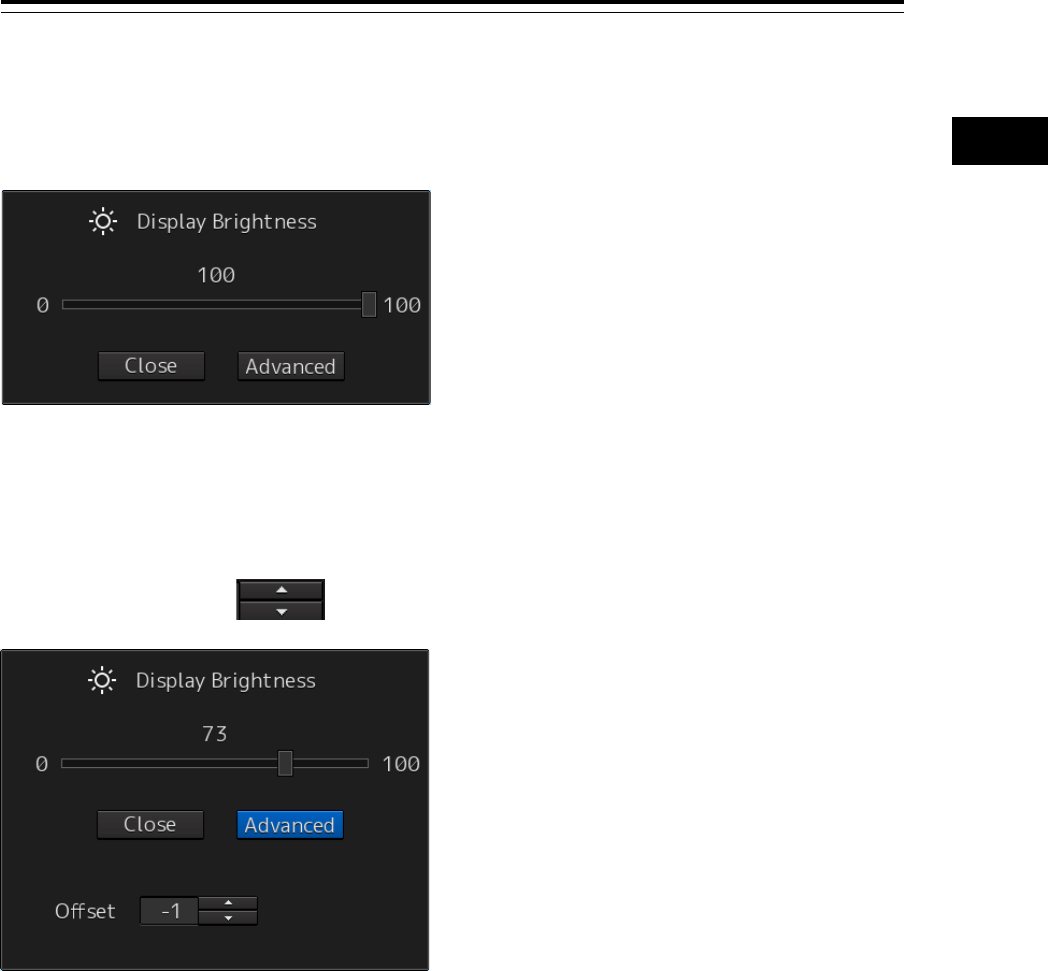
3-35 Section 3 Common Basic Operations
1
2
3
4
5
6
7
8
9
10
11
12
13
14
15
16
17
18
19
20
21
22
23
24
25
APP A
APP B
1
"Display Brightness" dialog
If the [MULTI] dial is operated while [Display Brightness] function is selected as the [MULTI] dial
assignment function, the "Display Brightness" dialog is displayed.
It is possible to adjust the brightness of the display section by rotating the [MULTI] dial.
In order to set an offset value so that when set to the same value as the screen brightness of other
equipment, the light emitted becomes the same as in other equipment, click the [Advanced] button and
adjust the offset using the buttons displayed for setting the [Offset].
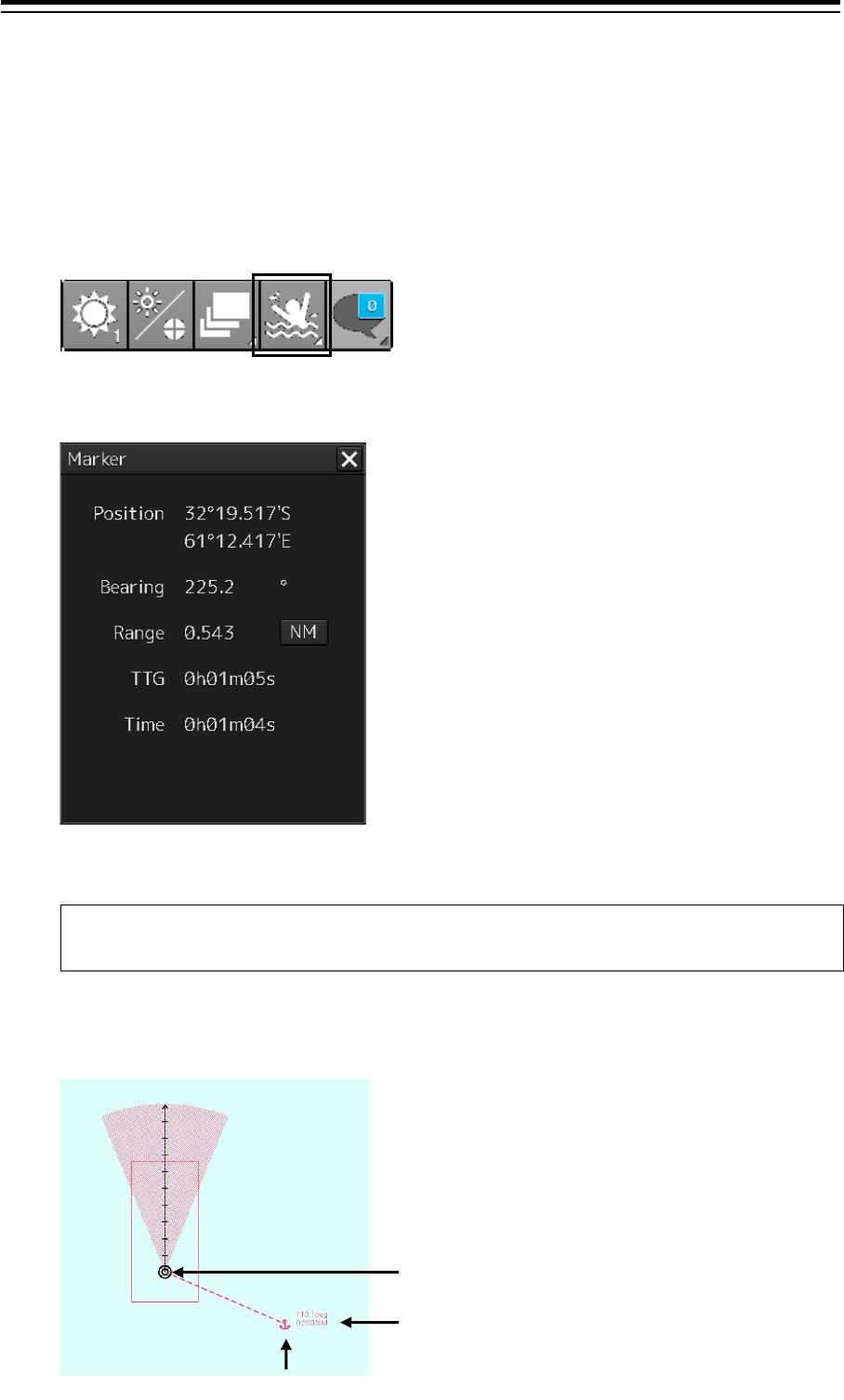
Section 3 Common Basic Operations 3-36
3.10 MOB (Man Over Board)
When a person falls overboard, this monitoring function prevents loss of sight of the position of the
person overboard.
The MOB use procedure is as follows.
1 Click on the MOB button on the right toolbar.
The "Marker" dialog box appears and the MOB marker is displayed on the own ship’s position
when the button is clicked on.
Memo
The "Marker" dialog box appears by clicking [Tools] - [MOB] on the menu
2 Monitor with the screen and the "Marker" dialog box.
The position relationship between the own ship that is moving and the MOB marker is displayed
as follows.
"Marker" Dialog Box
MOB marker
Position and bearing from own ship
Own ship's symbol
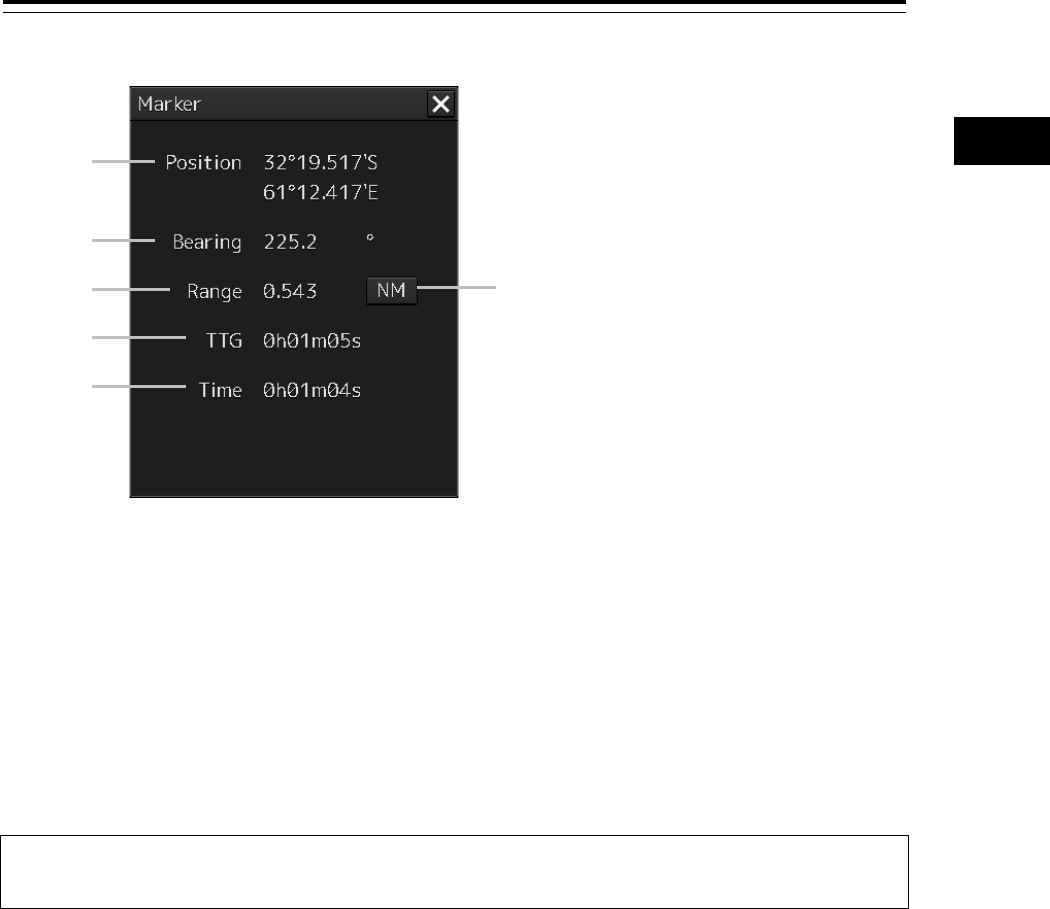
3-37 Section 3 Common Basic Operations
1
2
3
4
5
6
7
8
9
10
11
12
13
14
15
16
17
18
19
20
21
22
23
24
25
APP A
APP B
1
See below for how to reference the "Marker" dialog box.
[1] [Position]
Displays the coordinate of the MOB marker.
[2] [Bearing]
Displays the bearing from the own ship to the MOB marker.
[3] [Range]
Displays the range from the own ship to the MOB marker.
[4] NM/Km/sm switching button
Whenever this button is clicked on, the unit of [Range] is switched to NM, km or sm.
Memo
NM denotes nautical mile, sm denotes statute mile, and km denotes kilometer.
[5] [TTG]
Displays the time to reach the MOB marker from the ship speed.
[6] [Time]
Displays the time elapsed after clicking on the [MOB] button.
[1]
[2]
[3]
[5]
[6]
[4]
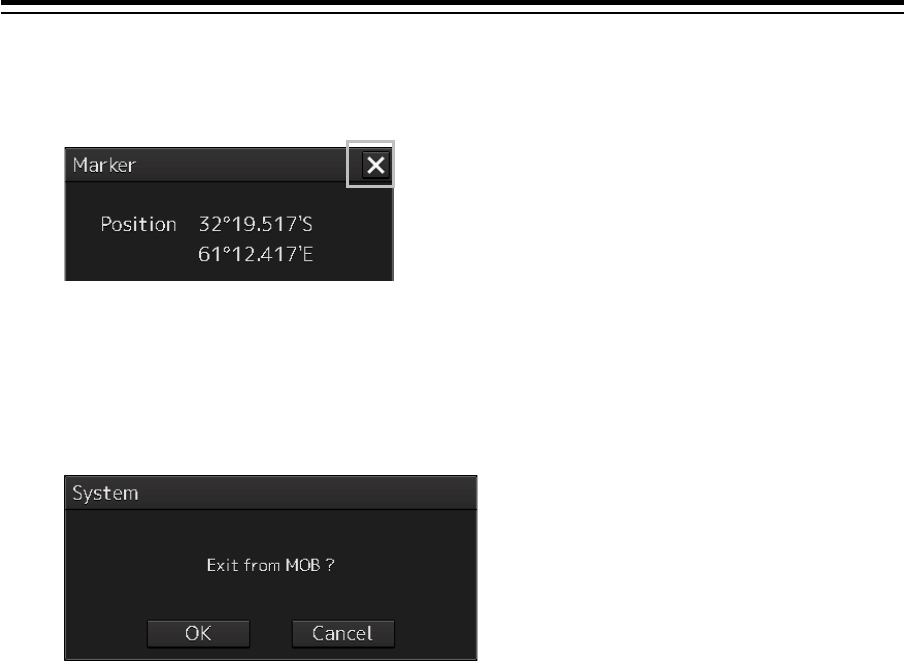
Section 3 Common Basic Operations 3-38
To exit from MOB
1 Click the [X] button in the Marker dialog box.
A confirmation dialog box appears.
2 Click on the [OK] button.
The "Marker" dialog is closed.
The MOB marker is cleared